Marketing of Nike in China
VerifiedAdded on 2023/05/27
|19
|5080
|467
AI Summary
The study evaluates the current marketing strategy of Nike in China. It includes a PEST analysis of China, analysis of the competitive advantage and USP of Nike, and STP (Segmentation, Targeting, and Positioning) strategies. The study also highlights the impact of political, economic, and technological factors on Nike's business in China.
Contribute Materials
Your contribution can guide someone’s learning journey. Share your
documents today.
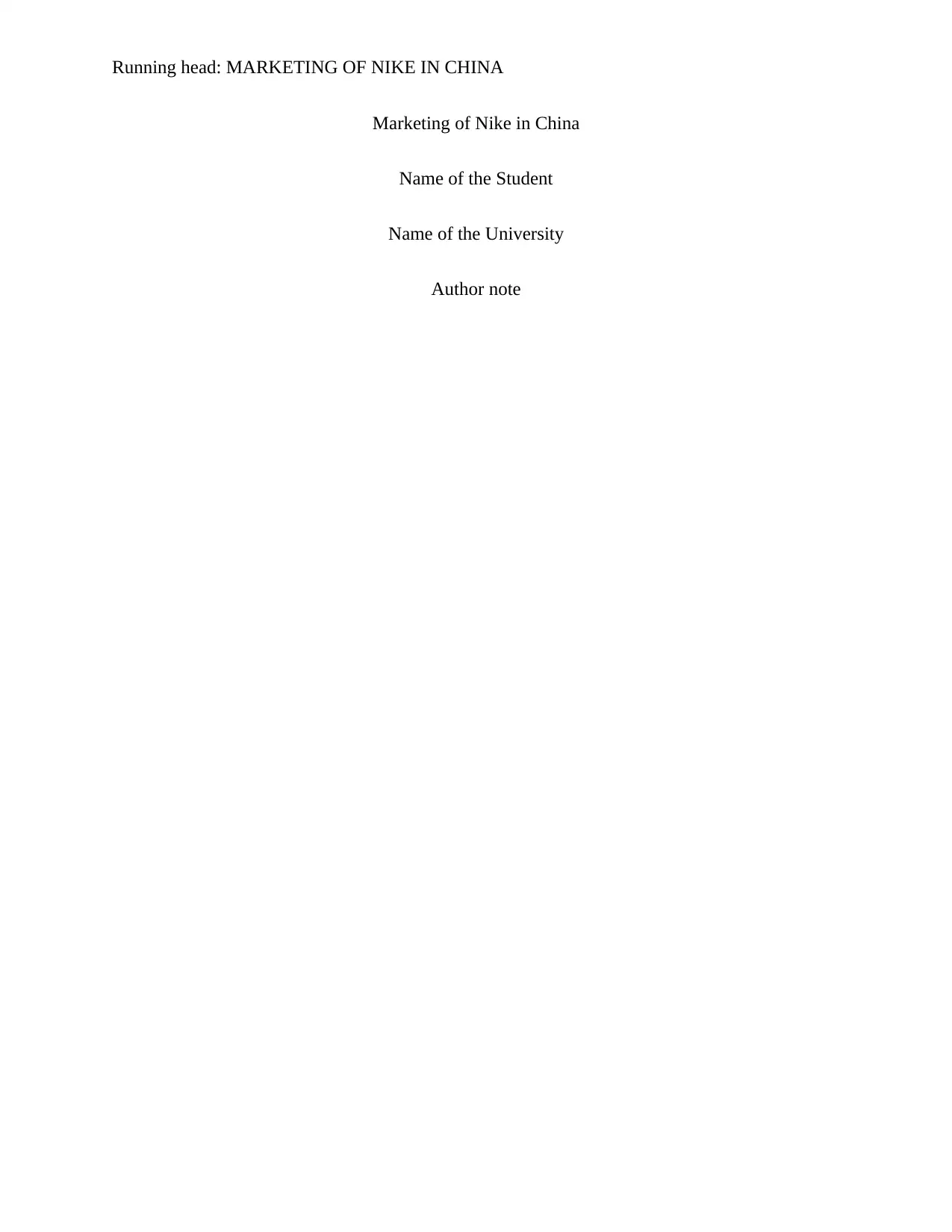
Running head: MARKETING OF NIKE IN CHINA
Marketing of Nike in China
Name of the Student
Name of the University
Author note
Marketing of Nike in China
Name of the Student
Name of the University
Author note
Secure Best Marks with AI Grader
Need help grading? Try our AI Grader for instant feedback on your assignments.
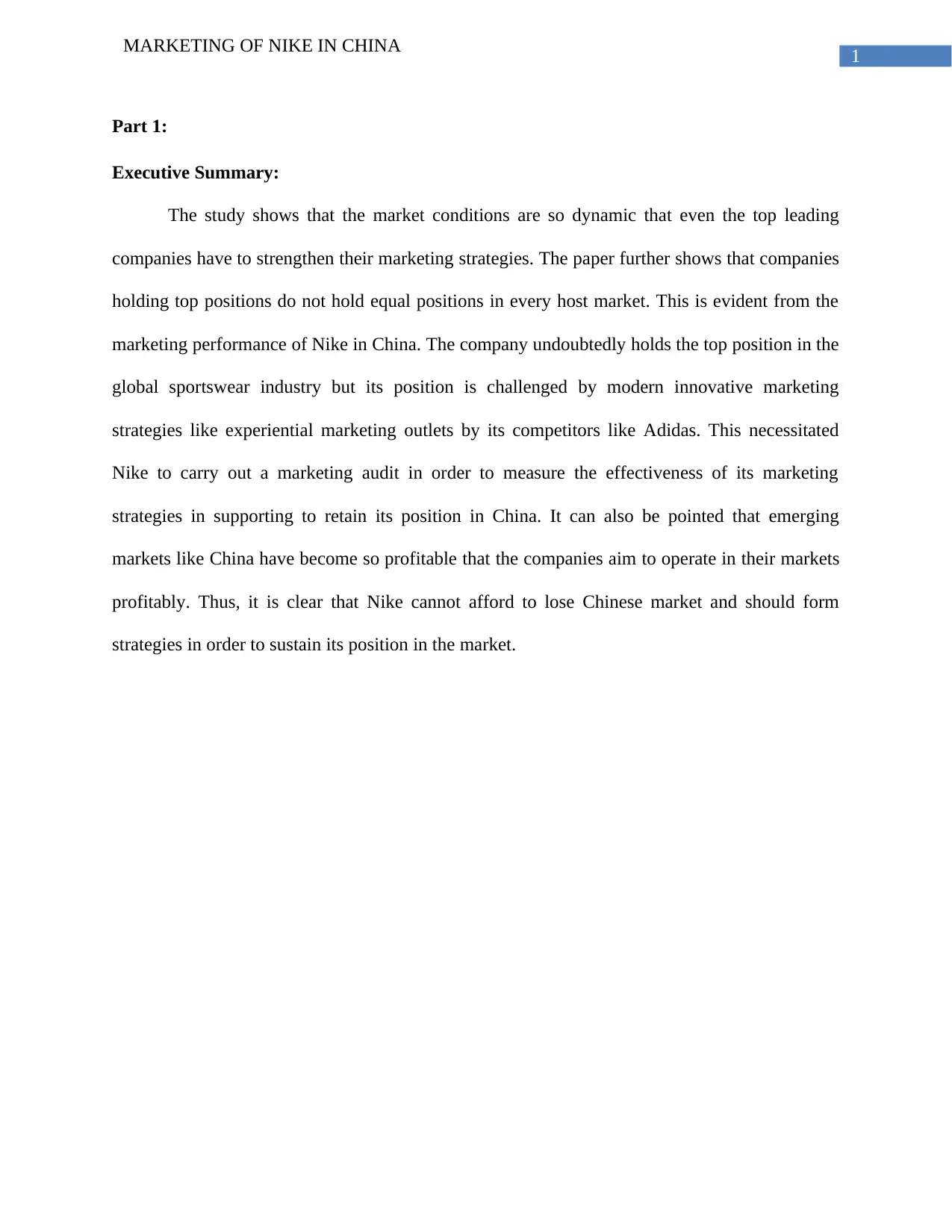
1
MARKETING OF NIKE IN CHINA
Part 1:
Executive Summary:
The study shows that the market conditions are so dynamic that even the top leading
companies have to strengthen their marketing strategies. The paper further shows that companies
holding top positions do not hold equal positions in every host market. This is evident from the
marketing performance of Nike in China. The company undoubtedly holds the top position in the
global sportswear industry but its position is challenged by modern innovative marketing
strategies like experiential marketing outlets by its competitors like Adidas. This necessitated
Nike to carry out a marketing audit in order to measure the effectiveness of its marketing
strategies in supporting to retain its position in China. It can also be pointed that emerging
markets like China have become so profitable that the companies aim to operate in their markets
profitably. Thus, it is clear that Nike cannot afford to lose Chinese market and should form
strategies in order to sustain its position in the market.
MARKETING OF NIKE IN CHINA
Part 1:
Executive Summary:
The study shows that the market conditions are so dynamic that even the top leading
companies have to strengthen their marketing strategies. The paper further shows that companies
holding top positions do not hold equal positions in every host market. This is evident from the
marketing performance of Nike in China. The company undoubtedly holds the top position in the
global sportswear industry but its position is challenged by modern innovative marketing
strategies like experiential marketing outlets by its competitors like Adidas. This necessitated
Nike to carry out a marketing audit in order to measure the effectiveness of its marketing
strategies in supporting to retain its position in China. It can also be pointed that emerging
markets like China have become so profitable that the companies aim to operate in their markets
profitably. Thus, it is clear that Nike cannot afford to lose Chinese market and should form
strategies in order to sustain its position in the market.
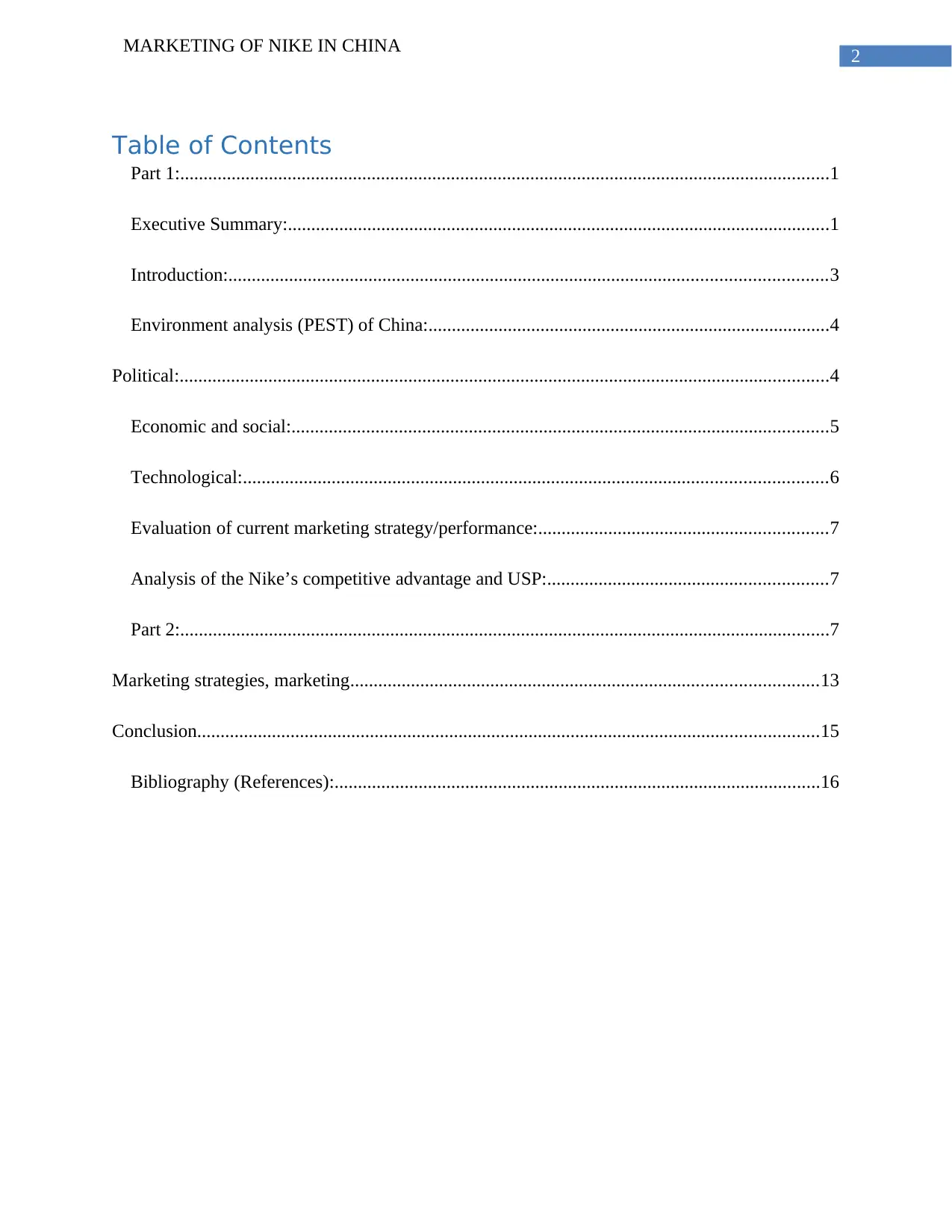
2
MARKETING OF NIKE IN CHINA
Table of Contents
Part 1:...........................................................................................................................................1
Executive Summary:....................................................................................................................1
Introduction:................................................................................................................................3
Environment analysis (PEST) of China:......................................................................................4
Political:...........................................................................................................................................4
Economic and social:...................................................................................................................5
Technological:.............................................................................................................................6
Evaluation of current marketing strategy/performance:..............................................................7
Analysis of the Nike’s competitive advantage and USP:............................................................7
Part 2:...........................................................................................................................................7
Marketing strategies, marketing....................................................................................................13
Conclusion.....................................................................................................................................15
Bibliography (References):........................................................................................................16
MARKETING OF NIKE IN CHINA
Table of Contents
Part 1:...........................................................................................................................................1
Executive Summary:....................................................................................................................1
Introduction:................................................................................................................................3
Environment analysis (PEST) of China:......................................................................................4
Political:...........................................................................................................................................4
Economic and social:...................................................................................................................5
Technological:.............................................................................................................................6
Evaluation of current marketing strategy/performance:..............................................................7
Analysis of the Nike’s competitive advantage and USP:............................................................7
Part 2:...........................................................................................................................................7
Marketing strategies, marketing....................................................................................................13
Conclusion.....................................................................................................................................15
Bibliography (References):........................................................................................................16

3
MARKETING OF NIKE IN CHINA
Introduction:
Marketing of sporting footwear has become so competitive with both international and
local companies competing to maintain their market position as well as upgrade their positions in
the future that even the top brands in the market have to restructure their respective market
positions. According to the international magazine, the Forbes, commanding a brand value of $
15,000,000,000, Nike based in the United States of America holds a whopping 38 percent share
of the sportswear market internationally1. The same report shows that the German company,
Adidas and Reebok, based in the United States are closing onto the second and third positions
respectively. The Forbes magazine in another article shows that lack of efficient stock
management and weak sales strategy has resulted in low profit of Nike in China. The article on
the Forbes Magazine further reports that the cut throat competitors of Nike like Adidas are
launching concept stores in China to enhance the customer experience, a strategy which is
predicted to boost the sales for the latter companies2. The strategy in other words if successful
would result in weakening the position of Nike in the Chinese market. Moreover, weakening
sales and lack of management of inventory of Nike in China clearly point out that the leading
sportswear company requires forming powerful marketing strategy to retain its position in
China3. These three articles from the Forbes would form the perfect ground for the study. The
aim of the study would be evaluation of the current marketing strategy of Nike with respect to
China.
1 "Forbes.Com". Forbes.Com, 2018, https://www.forbes.com/pictures/mlm45jemm/1-nike/#41be0433314e.
Accessed 30 Dec 2018.
2 "Forbes.Com". Forbes.Com, 2018, https://www.forbes.com/sites/greatspeculations/2014/03/04/nike-faces-tough-
competition-in-europe-and-china/#2bbb26df6e79. Accessed 30 Dec 2018.
3 "Forbes.Com". Forbes.Com, 2018, https://www.forbes.com/sites/deborahweinswig/2018/09/17/millennials-a-pro-
sports-government-and-large-sports-events-drive-the-china-sportswear-market/#4f231e6d796c. Accessed 30 Dec
2018.
MARKETING OF NIKE IN CHINA
Introduction:
Marketing of sporting footwear has become so competitive with both international and
local companies competing to maintain their market position as well as upgrade their positions in
the future that even the top brands in the market have to restructure their respective market
positions. According to the international magazine, the Forbes, commanding a brand value of $
15,000,000,000, Nike based in the United States of America holds a whopping 38 percent share
of the sportswear market internationally1. The same report shows that the German company,
Adidas and Reebok, based in the United States are closing onto the second and third positions
respectively. The Forbes magazine in another article shows that lack of efficient stock
management and weak sales strategy has resulted in low profit of Nike in China. The article on
the Forbes Magazine further reports that the cut throat competitors of Nike like Adidas are
launching concept stores in China to enhance the customer experience, a strategy which is
predicted to boost the sales for the latter companies2. The strategy in other words if successful
would result in weakening the position of Nike in the Chinese market. Moreover, weakening
sales and lack of management of inventory of Nike in China clearly point out that the leading
sportswear company requires forming powerful marketing strategy to retain its position in
China3. These three articles from the Forbes would form the perfect ground for the study. The
aim of the study would be evaluation of the current marketing strategy of Nike with respect to
China.
1 "Forbes.Com". Forbes.Com, 2018, https://www.forbes.com/pictures/mlm45jemm/1-nike/#41be0433314e.
Accessed 30 Dec 2018.
2 "Forbes.Com". Forbes.Com, 2018, https://www.forbes.com/sites/greatspeculations/2014/03/04/nike-faces-tough-
competition-in-europe-and-china/#2bbb26df6e79. Accessed 30 Dec 2018.
3 "Forbes.Com". Forbes.Com, 2018, https://www.forbes.com/sites/deborahweinswig/2018/09/17/millennials-a-pro-
sports-government-and-large-sports-events-drive-the-china-sportswear-market/#4f231e6d796c. Accessed 30 Dec
2018.
Secure Best Marks with AI Grader
Need help grading? Try our AI Grader for instant feedback on your assignments.

4
MARKETING OF NIKE IN CHINA
The study would be initiated with a PEST analysis of China followed by an analysis of
the current competitive advantage and USP of the company on the grounds of the findings of the
PEST analysis. This would be followed by an STP of the company succeeded by
recommendation of marketing goals and objectives. This would be followed by identifying
appropriate marketing strategies for the company with respect to China. Since, Nike has a huge
product line, the study would concentrate on the shoes Nike markets to narrow down the study in
order to be able to propose appropriate marketing strategies.
Environment analysis (PEST) of China:
The following is the environment analysis of China using the PEST framework:
Political:
The political factors play significant roles in the expansion of industries into host
countries. Political factors plays significant roles especially for transnational companies which
includes leading sportswear companies. This is evident from the fact that most of the leading
sportswear companies are based in the western markets like the US while the booming
sportswear markets are slowly shifting in emerging countries like China. China, like the US is a
republican country with the President as the head of state. The Chinese government makes laws
to promote entry of foreign companies (like Nike) in the economy to promote the development
of the expanding market of China. The Chinese Government has strong political ties with several
European and American countries which are the home countries to leading international
sportswear companies. For example, the leading sportswear company, Nike is based in the US.
This means that the strong relationship of Beijing with Washington would pave ways for the
American sportswear companies including Nike to expand their business further into China. As
pointed out by the Walls Street Journal, the two countries are working towards strengthening
MARKETING OF NIKE IN CHINA
The study would be initiated with a PEST analysis of China followed by an analysis of
the current competitive advantage and USP of the company on the grounds of the findings of the
PEST analysis. This would be followed by an STP of the company succeeded by
recommendation of marketing goals and objectives. This would be followed by identifying
appropriate marketing strategies for the company with respect to China. Since, Nike has a huge
product line, the study would concentrate on the shoes Nike markets to narrow down the study in
order to be able to propose appropriate marketing strategies.
Environment analysis (PEST) of China:
The following is the environment analysis of China using the PEST framework:
Political:
The political factors play significant roles in the expansion of industries into host
countries. Political factors plays significant roles especially for transnational companies which
includes leading sportswear companies. This is evident from the fact that most of the leading
sportswear companies are based in the western markets like the US while the booming
sportswear markets are slowly shifting in emerging countries like China. China, like the US is a
republican country with the President as the head of state. The Chinese government makes laws
to promote entry of foreign companies (like Nike) in the economy to promote the development
of the expanding market of China. The Chinese Government has strong political ties with several
European and American countries which are the home countries to leading international
sportswear companies. For example, the leading sportswear company, Nike is based in the US.
This means that the strong relationship of Beijing with Washington would pave ways for the
American sportswear companies including Nike to expand their business further into China. As
pointed out by the Walls Street Journal, the two countries are working towards strengthening
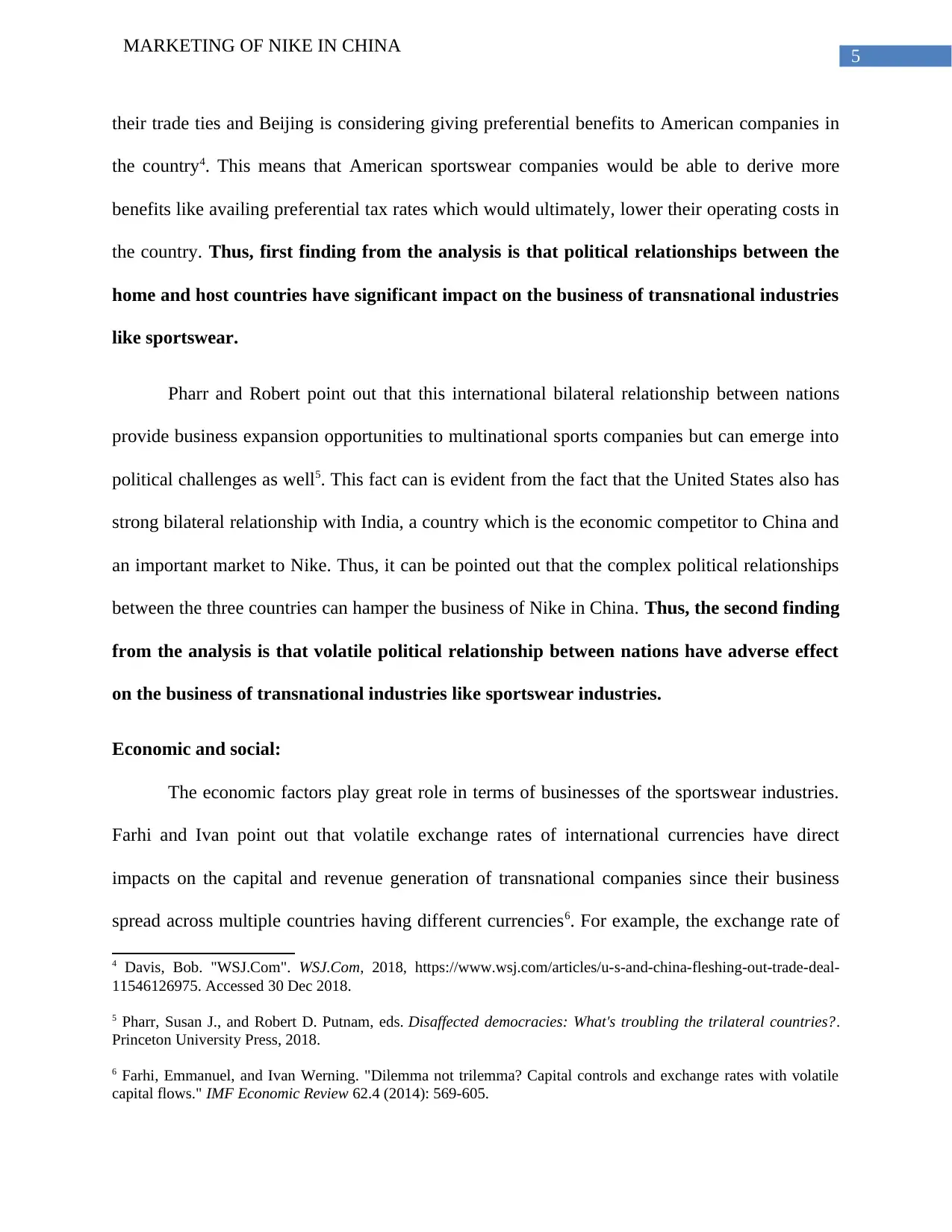
5
MARKETING OF NIKE IN CHINA
their trade ties and Beijing is considering giving preferential benefits to American companies in
the country4. This means that American sportswear companies would be able to derive more
benefits like availing preferential tax rates which would ultimately, lower their operating costs in
the country. Thus, first finding from the analysis is that political relationships between the
home and host countries have significant impact on the business of transnational industries
like sportswear.
Pharr and Robert point out that this international bilateral relationship between nations
provide business expansion opportunities to multinational sports companies but can emerge into
political challenges as well5. This fact can is evident from the fact that the United States also has
strong bilateral relationship with India, a country which is the economic competitor to China and
an important market to Nike. Thus, it can be pointed out that the complex political relationships
between the three countries can hamper the business of Nike in China. Thus, the second finding
from the analysis is that volatile political relationship between nations have adverse effect
on the business of transnational industries like sportswear industries.
Economic and social:
The economic factors play great role in terms of businesses of the sportswear industries.
Farhi and Ivan point out that volatile exchange rates of international currencies have direct
impacts on the capital and revenue generation of transnational companies since their business
spread across multiple countries having different currencies6. For example, the exchange rate of
4 Davis, Bob. "WSJ.Com". WSJ.Com, 2018, https://www.wsj.com/articles/u-s-and-china-fleshing-out-trade-deal-
11546126975. Accessed 30 Dec 2018.
5 Pharr, Susan J., and Robert D. Putnam, eds. Disaffected democracies: What's troubling the trilateral countries?.
Princeton University Press, 2018.
6 Farhi, Emmanuel, and Ivan Werning. "Dilemma not trilemma? Capital controls and exchange rates with volatile
capital flows." IMF Economic Review 62.4 (2014): 569-605.
MARKETING OF NIKE IN CHINA
their trade ties and Beijing is considering giving preferential benefits to American companies in
the country4. This means that American sportswear companies would be able to derive more
benefits like availing preferential tax rates which would ultimately, lower their operating costs in
the country. Thus, first finding from the analysis is that political relationships between the
home and host countries have significant impact on the business of transnational industries
like sportswear.
Pharr and Robert point out that this international bilateral relationship between nations
provide business expansion opportunities to multinational sports companies but can emerge into
political challenges as well5. This fact can is evident from the fact that the United States also has
strong bilateral relationship with India, a country which is the economic competitor to China and
an important market to Nike. Thus, it can be pointed out that the complex political relationships
between the three countries can hamper the business of Nike in China. Thus, the second finding
from the analysis is that volatile political relationship between nations have adverse effect
on the business of transnational industries like sportswear industries.
Economic and social:
The economic factors play great role in terms of businesses of the sportswear industries.
Farhi and Ivan point out that volatile exchange rates of international currencies have direct
impacts on the capital and revenue generation of transnational companies since their business
spread across multiple countries having different currencies6. For example, the exchange rate of
4 Davis, Bob. "WSJ.Com". WSJ.Com, 2018, https://www.wsj.com/articles/u-s-and-china-fleshing-out-trade-deal-
11546126975. Accessed 30 Dec 2018.
5 Pharr, Susan J., and Robert D. Putnam, eds. Disaffected democracies: What's troubling the trilateral countries?.
Princeton University Press, 2018.
6 Farhi, Emmanuel, and Ivan Werning. "Dilemma not trilemma? Capital controls and exchange rates with volatile
capital flows." IMF Economic Review 62.4 (2014): 569-605.
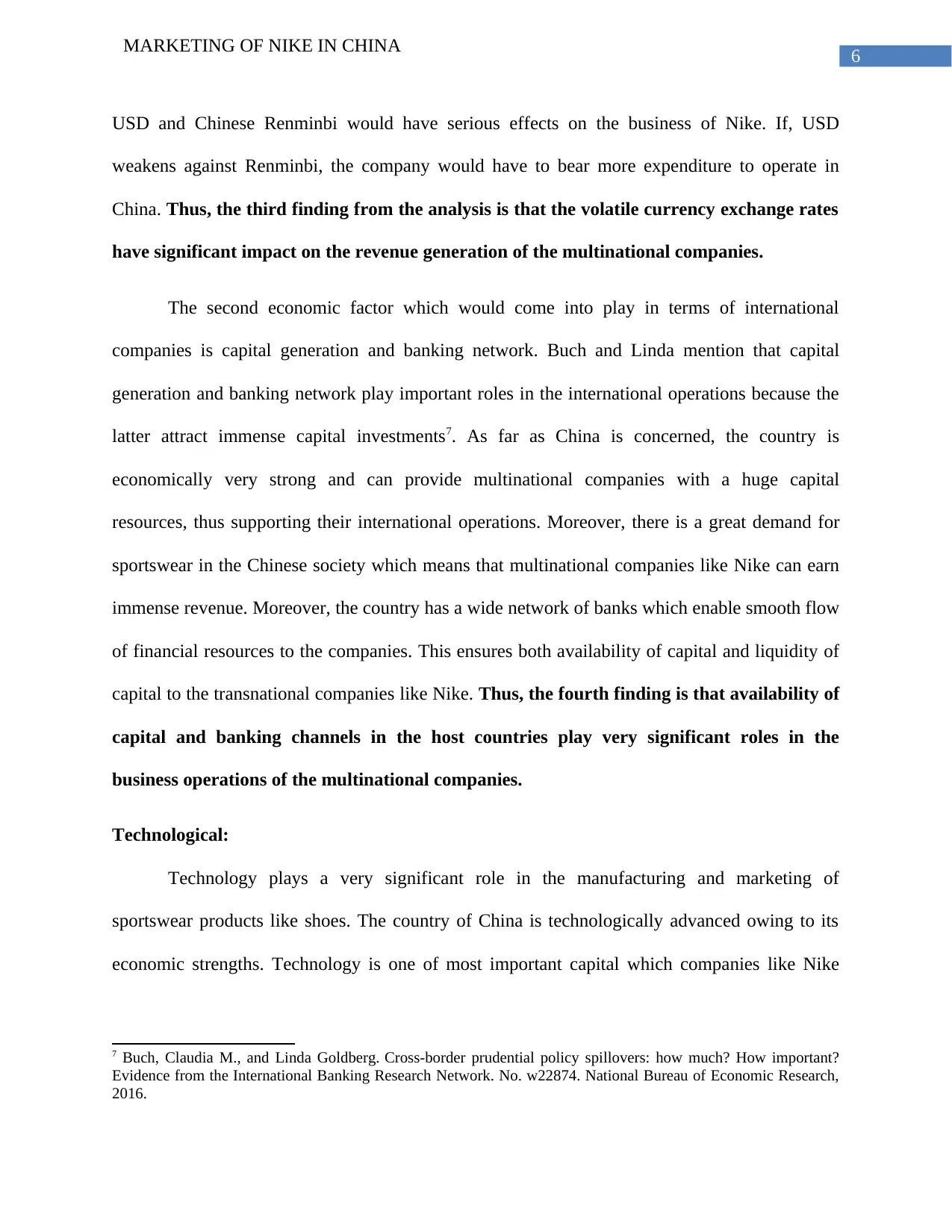
6
MARKETING OF NIKE IN CHINA
USD and Chinese Renminbi would have serious effects on the business of Nike. If, USD
weakens against Renminbi, the company would have to bear more expenditure to operate in
China. Thus, the third finding from the analysis is that the volatile currency exchange rates
have significant impact on the revenue generation of the multinational companies.
The second economic factor which would come into play in terms of international
companies is capital generation and banking network. Buch and Linda mention that capital
generation and banking network play important roles in the international operations because the
latter attract immense capital investments7. As far as China is concerned, the country is
economically very strong and can provide multinational companies with a huge capital
resources, thus supporting their international operations. Moreover, there is a great demand for
sportswear in the Chinese society which means that multinational companies like Nike can earn
immense revenue. Moreover, the country has a wide network of banks which enable smooth flow
of financial resources to the companies. This ensures both availability of capital and liquidity of
capital to the transnational companies like Nike. Thus, the fourth finding is that availability of
capital and banking channels in the host countries play very significant roles in the
business operations of the multinational companies.
Technological:
Technology plays a very significant role in the manufacturing and marketing of
sportswear products like shoes. The country of China is technologically advanced owing to its
economic strengths. Technology is one of most important capital which companies like Nike
7 Buch, Claudia M., and Linda Goldberg. Cross-border prudential policy spillovers: how much? How important?
Evidence from the International Banking Research Network. No. w22874. National Bureau of Economic Research,
2016.
MARKETING OF NIKE IN CHINA
USD and Chinese Renminbi would have serious effects on the business of Nike. If, USD
weakens against Renminbi, the company would have to bear more expenditure to operate in
China. Thus, the third finding from the analysis is that the volatile currency exchange rates
have significant impact on the revenue generation of the multinational companies.
The second economic factor which would come into play in terms of international
companies is capital generation and banking network. Buch and Linda mention that capital
generation and banking network play important roles in the international operations because the
latter attract immense capital investments7. As far as China is concerned, the country is
economically very strong and can provide multinational companies with a huge capital
resources, thus supporting their international operations. Moreover, there is a great demand for
sportswear in the Chinese society which means that multinational companies like Nike can earn
immense revenue. Moreover, the country has a wide network of banks which enable smooth flow
of financial resources to the companies. This ensures both availability of capital and liquidity of
capital to the transnational companies like Nike. Thus, the fourth finding is that availability of
capital and banking channels in the host countries play very significant roles in the
business operations of the multinational companies.
Technological:
Technology plays a very significant role in the manufacturing and marketing of
sportswear products like shoes. The country of China is technologically advanced owing to its
economic strengths. Technology is one of most important capital which companies like Nike
7 Buch, Claudia M., and Linda Goldberg. Cross-border prudential policy spillovers: how much? How important?
Evidence from the International Banking Research Network. No. w22874. National Bureau of Economic Research,
2016.
Paraphrase This Document
Need a fresh take? Get an instant paraphrase of this document with our AI Paraphraser
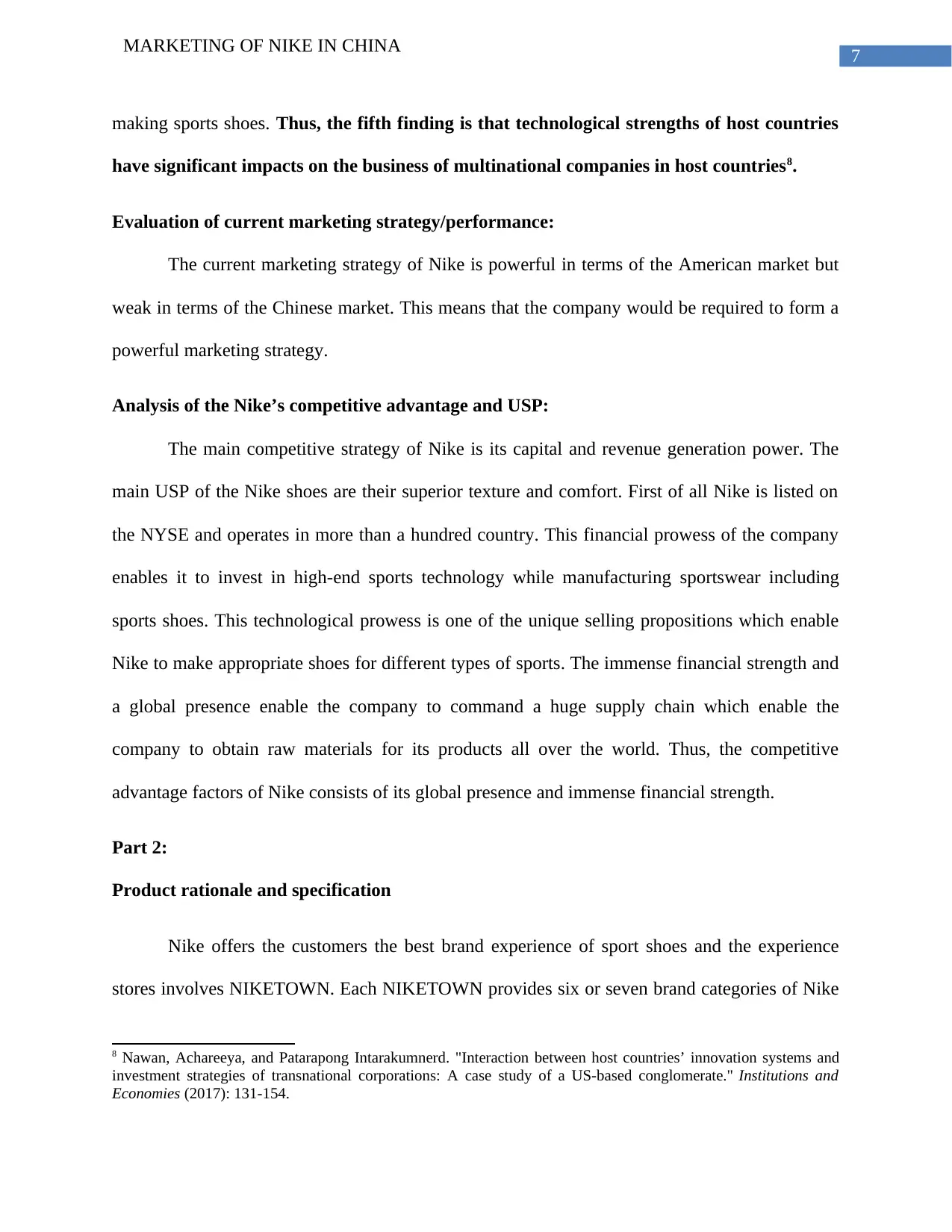
7
MARKETING OF NIKE IN CHINA
making sports shoes. Thus, the fifth finding is that technological strengths of host countries
have significant impacts on the business of multinational companies in host countries8.
Evaluation of current marketing strategy/performance:
The current marketing strategy of Nike is powerful in terms of the American market but
weak in terms of the Chinese market. This means that the company would be required to form a
powerful marketing strategy.
Analysis of the Nike’s competitive advantage and USP:
The main competitive strategy of Nike is its capital and revenue generation power. The
main USP of the Nike shoes are their superior texture and comfort. First of all Nike is listed on
the NYSE and operates in more than a hundred country. This financial prowess of the company
enables it to invest in high-end sports technology while manufacturing sportswear including
sports shoes. This technological prowess is one of the unique selling propositions which enable
Nike to make appropriate shoes for different types of sports. The immense financial strength and
a global presence enable the company to command a huge supply chain which enable the
company to obtain raw materials for its products all over the world. Thus, the competitive
advantage factors of Nike consists of its global presence and immense financial strength.
Part 2:
Product rationale and specification
Nike offers the customers the best brand experience of sport shoes and the experience
stores involves NIKETOWN. Each NIKETOWN provides six or seven brand categories of Nike
8 Nawan, Achareeya, and Patarapong Intarakumnerd. "Interaction between host countries’ innovation systems and
investment strategies of transnational corporations: A case study of a US-based conglomerate." Institutions and
Economies (2017): 131-154.
MARKETING OF NIKE IN CHINA
making sports shoes. Thus, the fifth finding is that technological strengths of host countries
have significant impacts on the business of multinational companies in host countries8.
Evaluation of current marketing strategy/performance:
The current marketing strategy of Nike is powerful in terms of the American market but
weak in terms of the Chinese market. This means that the company would be required to form a
powerful marketing strategy.
Analysis of the Nike’s competitive advantage and USP:
The main competitive strategy of Nike is its capital and revenue generation power. The
main USP of the Nike shoes are their superior texture and comfort. First of all Nike is listed on
the NYSE and operates in more than a hundred country. This financial prowess of the company
enables it to invest in high-end sports technology while manufacturing sportswear including
sports shoes. This technological prowess is one of the unique selling propositions which enable
Nike to make appropriate shoes for different types of sports. The immense financial strength and
a global presence enable the company to command a huge supply chain which enable the
company to obtain raw materials for its products all over the world. Thus, the competitive
advantage factors of Nike consists of its global presence and immense financial strength.
Part 2:
Product rationale and specification
Nike offers the customers the best brand experience of sport shoes and the experience
stores involves NIKETOWN. Each NIKETOWN provides six or seven brand categories of Nike
8 Nawan, Achareeya, and Patarapong Intarakumnerd. "Interaction between host countries’ innovation systems and
investment strategies of transnational corporations: A case study of a US-based conglomerate." Institutions and
Economies (2017): 131-154.
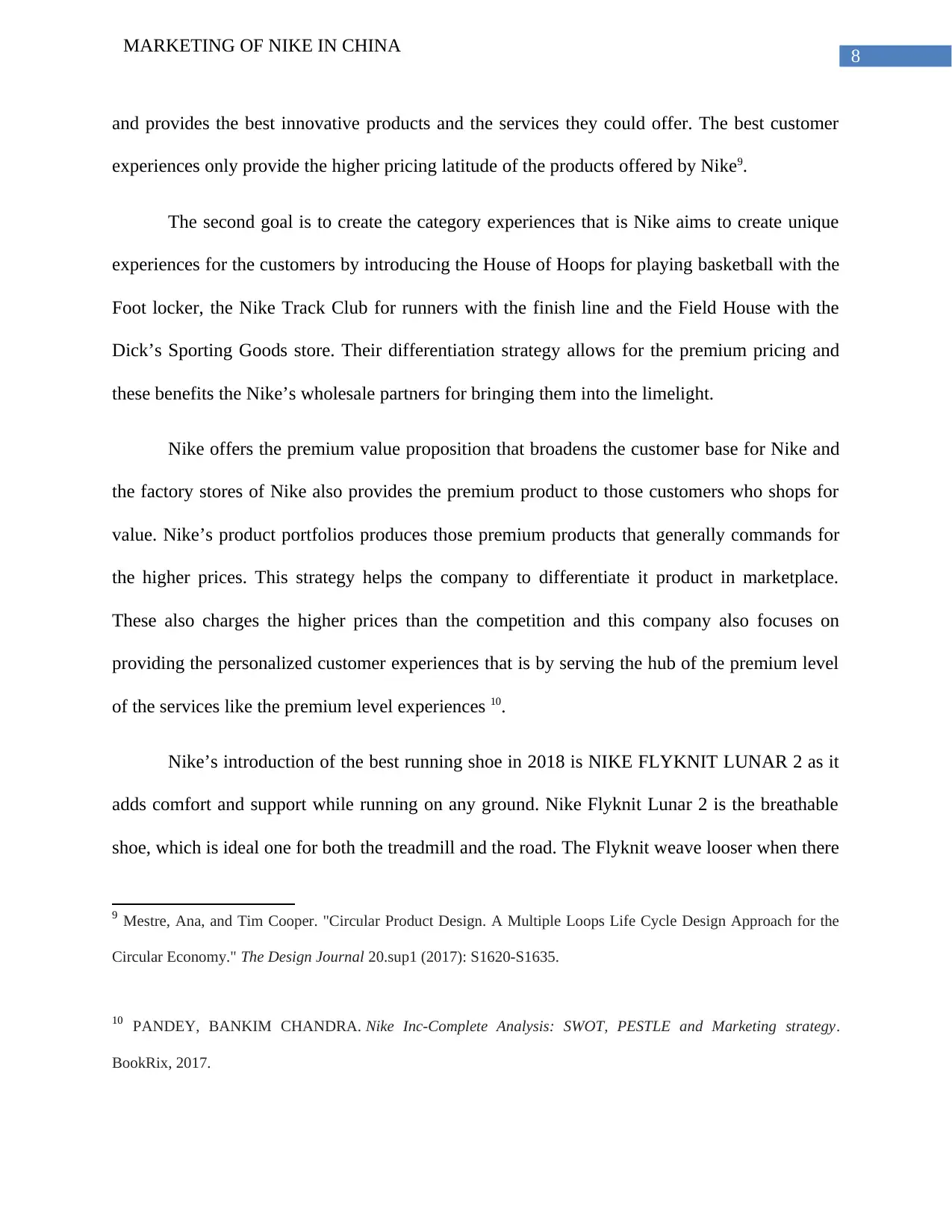
8
MARKETING OF NIKE IN CHINA
and provides the best innovative products and the services they could offer. The best customer
experiences only provide the higher pricing latitude of the products offered by Nike9.
The second goal is to create the category experiences that is Nike aims to create unique
experiences for the customers by introducing the House of Hoops for playing basketball with the
Foot locker, the Nike Track Club for runners with the finish line and the Field House with the
Dick’s Sporting Goods store. Their differentiation strategy allows for the premium pricing and
these benefits the Nike’s wholesale partners for bringing them into the limelight.
Nike offers the premium value proposition that broadens the customer base for Nike and
the factory stores of Nike also provides the premium product to those customers who shops for
value. Nike’s product portfolios produces those premium products that generally commands for
the higher prices. This strategy helps the company to differentiate it product in marketplace.
These also charges the higher prices than the competition and this company also focuses on
providing the personalized customer experiences that is by serving the hub of the premium level
of the services like the premium level experiences 10.
Nike’s introduction of the best running shoe in 2018 is NIKE FLYKNIT LUNAR 2 as it
adds comfort and support while running on any ground. Nike Flyknit Lunar 2 is the breathable
shoe, which is ideal one for both the treadmill and the road. The Flyknit weave looser when there
9 Mestre, Ana, and Tim Cooper. "Circular Product Design. A Multiple Loops Life Cycle Design Approach for the
Circular Economy." The Design Journal 20.sup1 (2017): S1620-S1635.
10 PANDEY, BANKIM CHANDRA. Nike Inc-Complete Analysis: SWOT, PESTLE and Marketing strategy.
BookRix, 2017.
MARKETING OF NIKE IN CHINA
and provides the best innovative products and the services they could offer. The best customer
experiences only provide the higher pricing latitude of the products offered by Nike9.
The second goal is to create the category experiences that is Nike aims to create unique
experiences for the customers by introducing the House of Hoops for playing basketball with the
Foot locker, the Nike Track Club for runners with the finish line and the Field House with the
Dick’s Sporting Goods store. Their differentiation strategy allows for the premium pricing and
these benefits the Nike’s wholesale partners for bringing them into the limelight.
Nike offers the premium value proposition that broadens the customer base for Nike and
the factory stores of Nike also provides the premium product to those customers who shops for
value. Nike’s product portfolios produces those premium products that generally commands for
the higher prices. This strategy helps the company to differentiate it product in marketplace.
These also charges the higher prices than the competition and this company also focuses on
providing the personalized customer experiences that is by serving the hub of the premium level
of the services like the premium level experiences 10.
Nike’s introduction of the best running shoe in 2018 is NIKE FLYKNIT LUNAR 2 as it
adds comfort and support while running on any ground. Nike Flyknit Lunar 2 is the breathable
shoe, which is ideal one for both the treadmill and the road. The Flyknit weave looser when there
9 Mestre, Ana, and Tim Cooper. "Circular Product Design. A Multiple Loops Life Cycle Design Approach for the
Circular Economy." The Design Journal 20.sup1 (2017): S1620-S1635.
10 PANDEY, BANKIM CHANDRA. Nike Inc-Complete Analysis: SWOT, PESTLE and Marketing strategy.
BookRix, 2017.
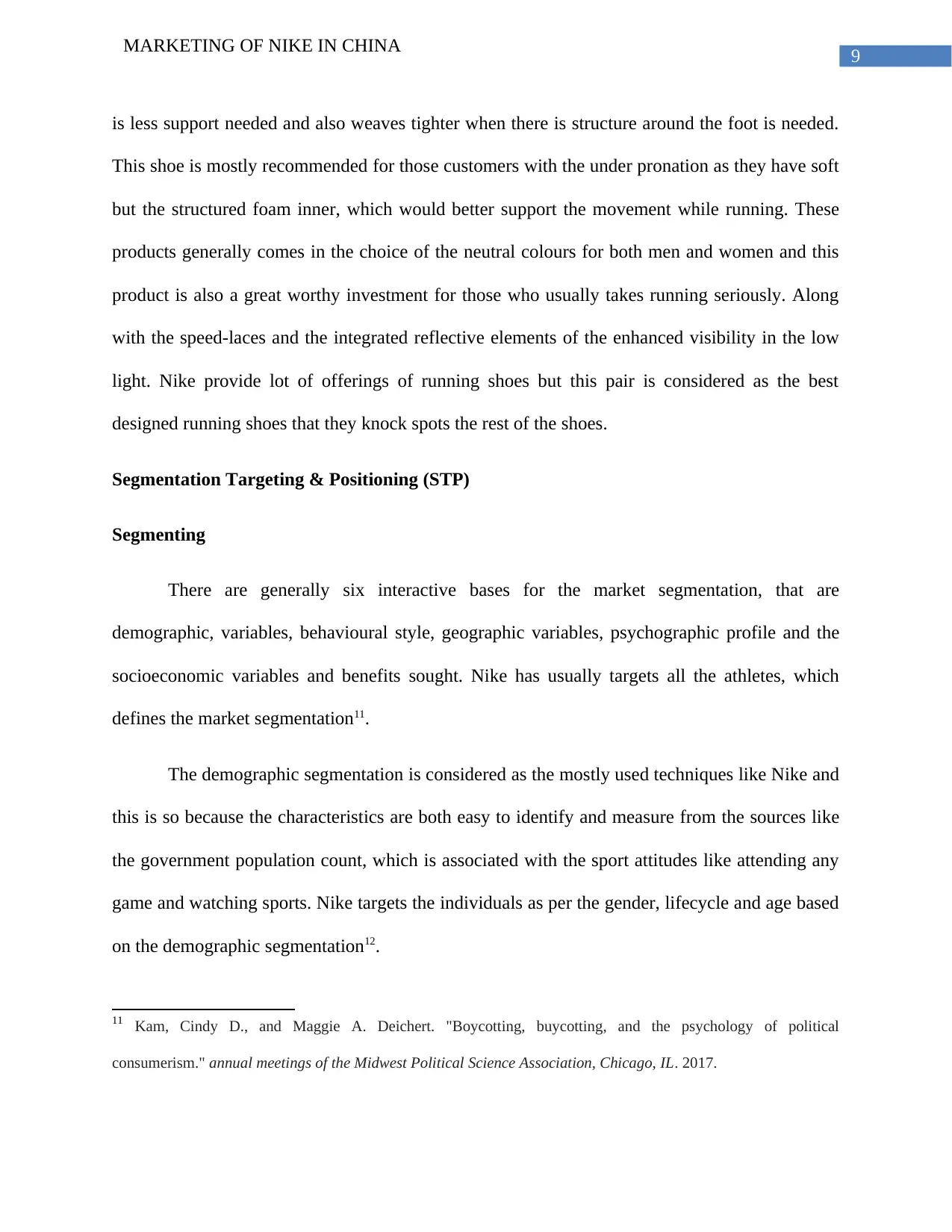
9
MARKETING OF NIKE IN CHINA
is less support needed and also weaves tighter when there is structure around the foot is needed.
This shoe is mostly recommended for those customers with the under pronation as they have soft
but the structured foam inner, which would better support the movement while running. These
products generally comes in the choice of the neutral colours for both men and women and this
product is also a great worthy investment for those who usually takes running seriously. Along
with the speed-laces and the integrated reflective elements of the enhanced visibility in the low
light. Nike provide lot of offerings of running shoes but this pair is considered as the best
designed running shoes that they knock spots the rest of the shoes.
Segmentation Targeting & Positioning (STP)
Segmenting
There are generally six interactive bases for the market segmentation, that are
demographic, variables, behavioural style, geographic variables, psychographic profile and the
socioeconomic variables and benefits sought. Nike has usually targets all the athletes, which
defines the market segmentation11.
The demographic segmentation is considered as the mostly used techniques like Nike and
this is so because the characteristics are both easy to identify and measure from the sources like
the government population count, which is associated with the sport attitudes like attending any
game and watching sports. Nike targets the individuals as per the gender, lifecycle and age based
on the demographic segmentation12.
11 Kam, Cindy D., and Maggie A. Deichert. "Boycotting, buycotting, and the psychology of political
consumerism." annual meetings of the Midwest Political Science Association, Chicago, IL. 2017.
MARKETING OF NIKE IN CHINA
is less support needed and also weaves tighter when there is structure around the foot is needed.
This shoe is mostly recommended for those customers with the under pronation as they have soft
but the structured foam inner, which would better support the movement while running. These
products generally comes in the choice of the neutral colours for both men and women and this
product is also a great worthy investment for those who usually takes running seriously. Along
with the speed-laces and the integrated reflective elements of the enhanced visibility in the low
light. Nike provide lot of offerings of running shoes but this pair is considered as the best
designed running shoes that they knock spots the rest of the shoes.
Segmentation Targeting & Positioning (STP)
Segmenting
There are generally six interactive bases for the market segmentation, that are
demographic, variables, behavioural style, geographic variables, psychographic profile and the
socioeconomic variables and benefits sought. Nike has usually targets all the athletes, which
defines the market segmentation11.
The demographic segmentation is considered as the mostly used techniques like Nike and
this is so because the characteristics are both easy to identify and measure from the sources like
the government population count, which is associated with the sport attitudes like attending any
game and watching sports. Nike targets the individuals as per the gender, lifecycle and age based
on the demographic segmentation12.
11 Kam, Cindy D., and Maggie A. Deichert. "Boycotting, buycotting, and the psychology of political
consumerism." annual meetings of the Midwest Political Science Association, Chicago, IL. 2017.
Secure Best Marks with AI Grader
Need help grading? Try our AI Grader for instant feedback on your assignments.
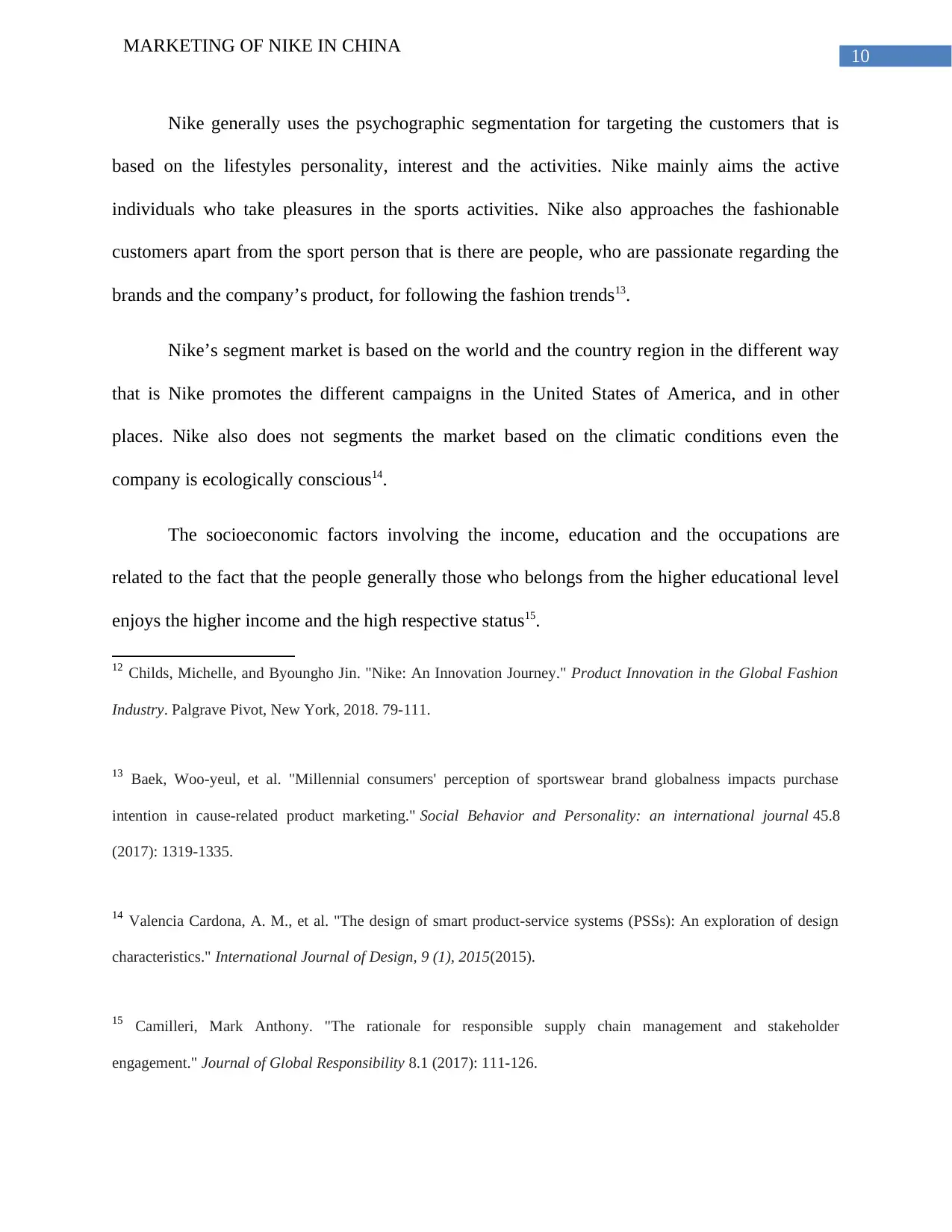
10
MARKETING OF NIKE IN CHINA
Nike generally uses the psychographic segmentation for targeting the customers that is
based on the lifestyles personality, interest and the activities. Nike mainly aims the active
individuals who take pleasures in the sports activities. Nike also approaches the fashionable
customers apart from the sport person that is there are people, who are passionate regarding the
brands and the company’s product, for following the fashion trends13.
Nike’s segment market is based on the world and the country region in the different way
that is Nike promotes the different campaigns in the United States of America, and in other
places. Nike also does not segments the market based on the climatic conditions even the
company is ecologically conscious14.
The socioeconomic factors involving the income, education and the occupations are
related to the fact that the people generally those who belongs from the higher educational level
enjoys the higher income and the high respective status15.
12 Childs, Michelle, and Byoungho Jin. "Nike: An Innovation Journey." Product Innovation in the Global Fashion
Industry. Palgrave Pivot, New York, 2018. 79-111.
13 Baek, Woo-yeul, et al. "Millennial consumers' perception of sportswear brand globalness impacts purchase
intention in cause-related product marketing." Social Behavior and Personality: an international journal 45.8
(2017): 1319-1335.
14 Valencia Cardona, A. M., et al. "The design of smart product-service systems (PSSs): An exploration of design
characteristics." International Journal of Design, 9 (1), 2015(2015).
15 Camilleri, Mark Anthony. "The rationale for responsible supply chain management and stakeholder
engagement." Journal of Global Responsibility 8.1 (2017): 111-126.
MARKETING OF NIKE IN CHINA
Nike generally uses the psychographic segmentation for targeting the customers that is
based on the lifestyles personality, interest and the activities. Nike mainly aims the active
individuals who take pleasures in the sports activities. Nike also approaches the fashionable
customers apart from the sport person that is there are people, who are passionate regarding the
brands and the company’s product, for following the fashion trends13.
Nike’s segment market is based on the world and the country region in the different way
that is Nike promotes the different campaigns in the United States of America, and in other
places. Nike also does not segments the market based on the climatic conditions even the
company is ecologically conscious14.
The socioeconomic factors involving the income, education and the occupations are
related to the fact that the people generally those who belongs from the higher educational level
enjoys the higher income and the high respective status15.
12 Childs, Michelle, and Byoungho Jin. "Nike: An Innovation Journey." Product Innovation in the Global Fashion
Industry. Palgrave Pivot, New York, 2018. 79-111.
13 Baek, Woo-yeul, et al. "Millennial consumers' perception of sportswear brand globalness impacts purchase
intention in cause-related product marketing." Social Behavior and Personality: an international journal 45.8
(2017): 1319-1335.
14 Valencia Cardona, A. M., et al. "The design of smart product-service systems (PSSs): An exploration of design
characteristics." International Journal of Design, 9 (1), 2015(2015).
15 Camilleri, Mark Anthony. "The rationale for responsible supply chain management and stakeholder
engagement." Journal of Global Responsibility 8.1 (2017): 111-126.
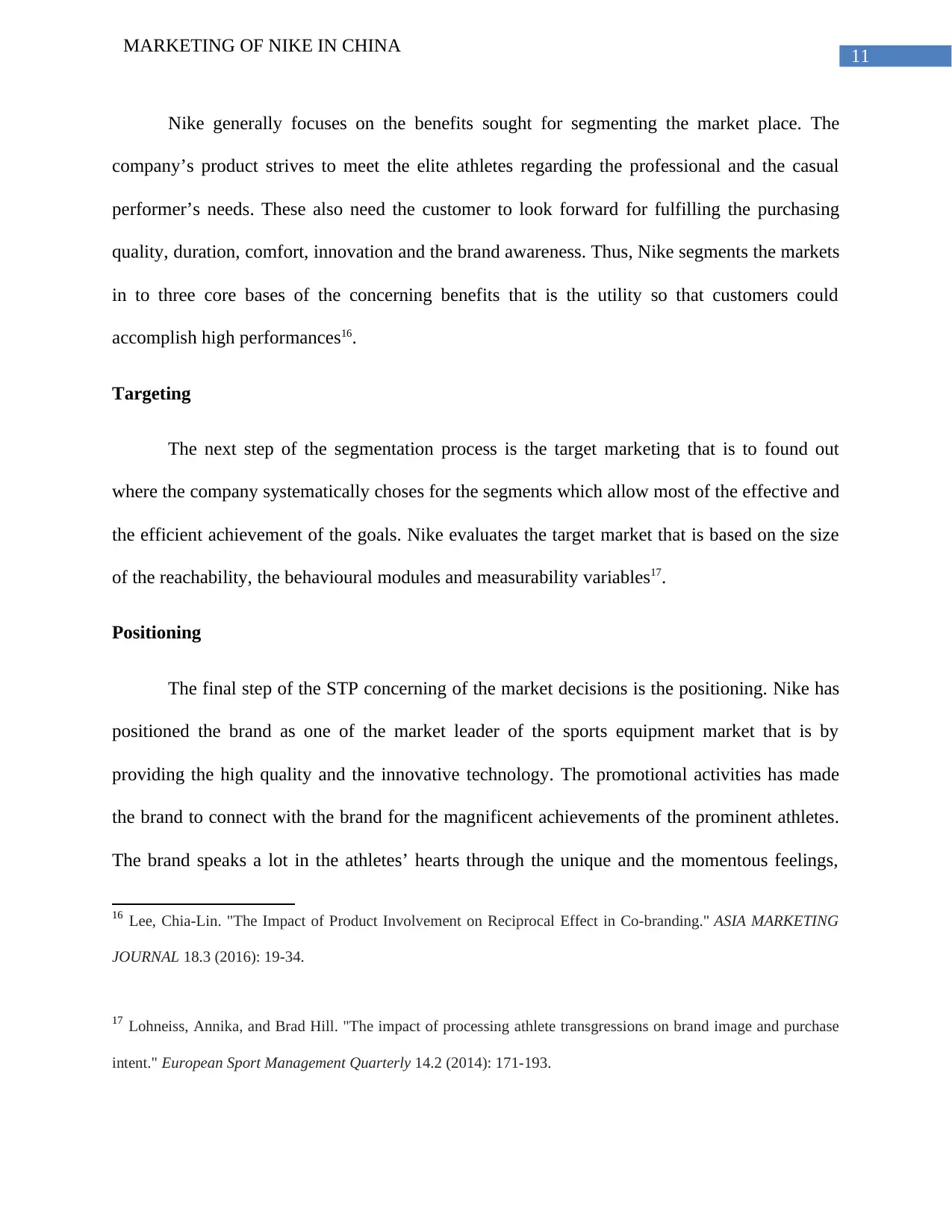
11
MARKETING OF NIKE IN CHINA
Nike generally focuses on the benefits sought for segmenting the market place. The
company’s product strives to meet the elite athletes regarding the professional and the casual
performer’s needs. These also need the customer to look forward for fulfilling the purchasing
quality, duration, comfort, innovation and the brand awareness. Thus, Nike segments the markets
in to three core bases of the concerning benefits that is the utility so that customers could
accomplish high performances16.
Targeting
The next step of the segmentation process is the target marketing that is to found out
where the company systematically choses for the segments which allow most of the effective and
the efficient achievement of the goals. Nike evaluates the target market that is based on the size
of the reachability, the behavioural modules and measurability variables17.
Positioning
The final step of the STP concerning of the market decisions is the positioning. Nike has
positioned the brand as one of the market leader of the sports equipment market that is by
providing the high quality and the innovative technology. The promotional activities has made
the brand to connect with the brand for the magnificent achievements of the prominent athletes.
The brand speaks a lot in the athletes’ hearts through the unique and the momentous feelings,
16 Lee, Chia-Lin. "The Impact of Product Involvement on Reciprocal Effect in Co-branding." ASIA MARKETING
JOURNAL 18.3 (2016): 19-34.
17 Lohneiss, Annika, and Brad Hill. "The impact of processing athlete transgressions on brand image and purchase
intent." European Sport Management Quarterly 14.2 (2014): 171-193.
MARKETING OF NIKE IN CHINA
Nike generally focuses on the benefits sought for segmenting the market place. The
company’s product strives to meet the elite athletes regarding the professional and the casual
performer’s needs. These also need the customer to look forward for fulfilling the purchasing
quality, duration, comfort, innovation and the brand awareness. Thus, Nike segments the markets
in to three core bases of the concerning benefits that is the utility so that customers could
accomplish high performances16.
Targeting
The next step of the segmentation process is the target marketing that is to found out
where the company systematically choses for the segments which allow most of the effective and
the efficient achievement of the goals. Nike evaluates the target market that is based on the size
of the reachability, the behavioural modules and measurability variables17.
Positioning
The final step of the STP concerning of the market decisions is the positioning. Nike has
positioned the brand as one of the market leader of the sports equipment market that is by
providing the high quality and the innovative technology. The promotional activities has made
the brand to connect with the brand for the magnificent achievements of the prominent athletes.
The brand speaks a lot in the athletes’ hearts through the unique and the momentous feelings,
16 Lee, Chia-Lin. "The Impact of Product Involvement on Reciprocal Effect in Co-branding." ASIA MARKETING
JOURNAL 18.3 (2016): 19-34.
17 Lohneiss, Annika, and Brad Hill. "The impact of processing athlete transgressions on brand image and purchase
intent." European Sport Management Quarterly 14.2 (2014): 171-193.
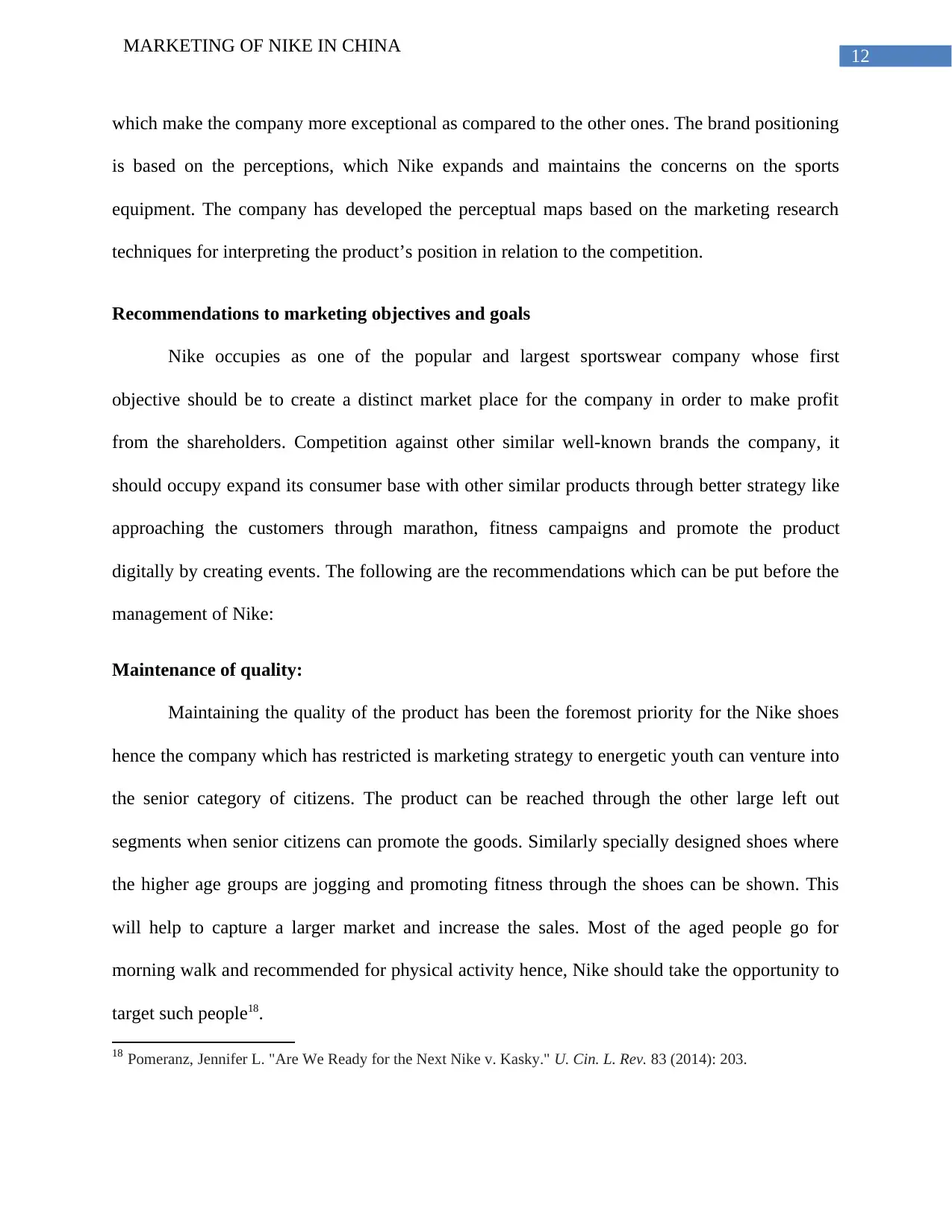
12
MARKETING OF NIKE IN CHINA
which make the company more exceptional as compared to the other ones. The brand positioning
is based on the perceptions, which Nike expands and maintains the concerns on the sports
equipment. The company has developed the perceptual maps based on the marketing research
techniques for interpreting the product’s position in relation to the competition.
Recommendations to marketing objectives and goals
Nike occupies as one of the popular and largest sportswear company whose first
objective should be to create a distinct market place for the company in order to make profit
from the shareholders. Competition against other similar well-known brands the company, it
should occupy expand its consumer base with other similar products through better strategy like
approaching the customers through marathon, fitness campaigns and promote the product
digitally by creating events. The following are the recommendations which can be put before the
management of Nike:
Maintenance of quality:
Maintaining the quality of the product has been the foremost priority for the Nike shoes
hence the company which has restricted is marketing strategy to energetic youth can venture into
the senior category of citizens. The product can be reached through the other large left out
segments when senior citizens can promote the goods. Similarly specially designed shoes where
the higher age groups are jogging and promoting fitness through the shoes can be shown. This
will help to capture a larger market and increase the sales. Most of the aged people go for
morning walk and recommended for physical activity hence, Nike should take the opportunity to
target such people18.
18 Pomeranz, Jennifer L. "Are We Ready for the Next Nike v. Kasky." U. Cin. L. Rev. 83 (2014): 203.
MARKETING OF NIKE IN CHINA
which make the company more exceptional as compared to the other ones. The brand positioning
is based on the perceptions, which Nike expands and maintains the concerns on the sports
equipment. The company has developed the perceptual maps based on the marketing research
techniques for interpreting the product’s position in relation to the competition.
Recommendations to marketing objectives and goals
Nike occupies as one of the popular and largest sportswear company whose first
objective should be to create a distinct market place for the company in order to make profit
from the shareholders. Competition against other similar well-known brands the company, it
should occupy expand its consumer base with other similar products through better strategy like
approaching the customers through marathon, fitness campaigns and promote the product
digitally by creating events. The following are the recommendations which can be put before the
management of Nike:
Maintenance of quality:
Maintaining the quality of the product has been the foremost priority for the Nike shoes
hence the company which has restricted is marketing strategy to energetic youth can venture into
the senior category of citizens. The product can be reached through the other large left out
segments when senior citizens can promote the goods. Similarly specially designed shoes where
the higher age groups are jogging and promoting fitness through the shoes can be shown. This
will help to capture a larger market and increase the sales. Most of the aged people go for
morning walk and recommended for physical activity hence, Nike should take the opportunity to
target such people18.
18 Pomeranz, Jennifer L. "Are We Ready for the Next Nike v. Kasky." U. Cin. L. Rev. 83 (2014): 203.
Paraphrase This Document
Need a fresh take? Get an instant paraphrase of this document with our AI Paraphraser
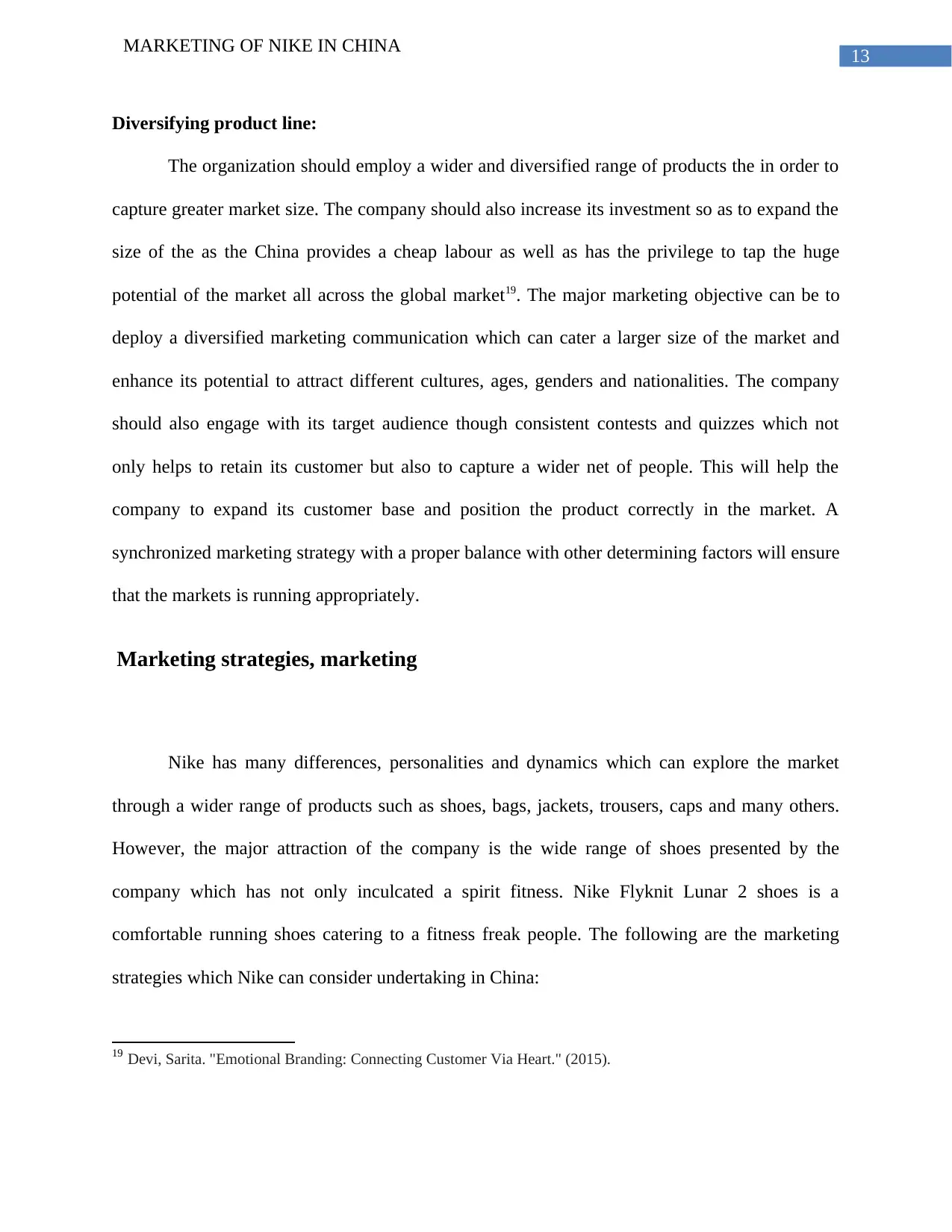
13
MARKETING OF NIKE IN CHINA
Diversifying product line:
The organization should employ a wider and diversified range of products the in order to
capture greater market size. The company should also increase its investment so as to expand the
size of the as the China provides a cheap labour as well as has the privilege to tap the huge
potential of the market all across the global market19. The major marketing objective can be to
deploy a diversified marketing communication which can cater a larger size of the market and
enhance its potential to attract different cultures, ages, genders and nationalities. The company
should also engage with its target audience though consistent contests and quizzes which not
only helps to retain its customer but also to capture a wider net of people. This will help the
company to expand its customer base and position the product correctly in the market. A
synchronized marketing strategy with a proper balance with other determining factors will ensure
that the markets is running appropriately.
Marketing strategies, marketing
Nike has many differences, personalities and dynamics which can explore the market
through a wider range of products such as shoes, bags, jackets, trousers, caps and many others.
However, the major attraction of the company is the wide range of shoes presented by the
company which has not only inculcated a spirit fitness. Nike Flyknit Lunar 2 shoes is a
comfortable running shoes catering to a fitness freak people. The following are the marketing
strategies which Nike can consider undertaking in China:
19 Devi, Sarita. "Emotional Branding: Connecting Customer Via Heart." (2015).
MARKETING OF NIKE IN CHINA
Diversifying product line:
The organization should employ a wider and diversified range of products the in order to
capture greater market size. The company should also increase its investment so as to expand the
size of the as the China provides a cheap labour as well as has the privilege to tap the huge
potential of the market all across the global market19. The major marketing objective can be to
deploy a diversified marketing communication which can cater a larger size of the market and
enhance its potential to attract different cultures, ages, genders and nationalities. The company
should also engage with its target audience though consistent contests and quizzes which not
only helps to retain its customer but also to capture a wider net of people. This will help the
company to expand its customer base and position the product correctly in the market. A
synchronized marketing strategy with a proper balance with other determining factors will ensure
that the markets is running appropriately.
Marketing strategies, marketing
Nike has many differences, personalities and dynamics which can explore the market
through a wider range of products such as shoes, bags, jackets, trousers, caps and many others.
However, the major attraction of the company is the wide range of shoes presented by the
company which has not only inculcated a spirit fitness. Nike Flyknit Lunar 2 shoes is a
comfortable running shoes catering to a fitness freak people. The following are the marketing
strategies which Nike can consider undertaking in China:
19 Devi, Sarita. "Emotional Branding: Connecting Customer Via Heart." (2015).
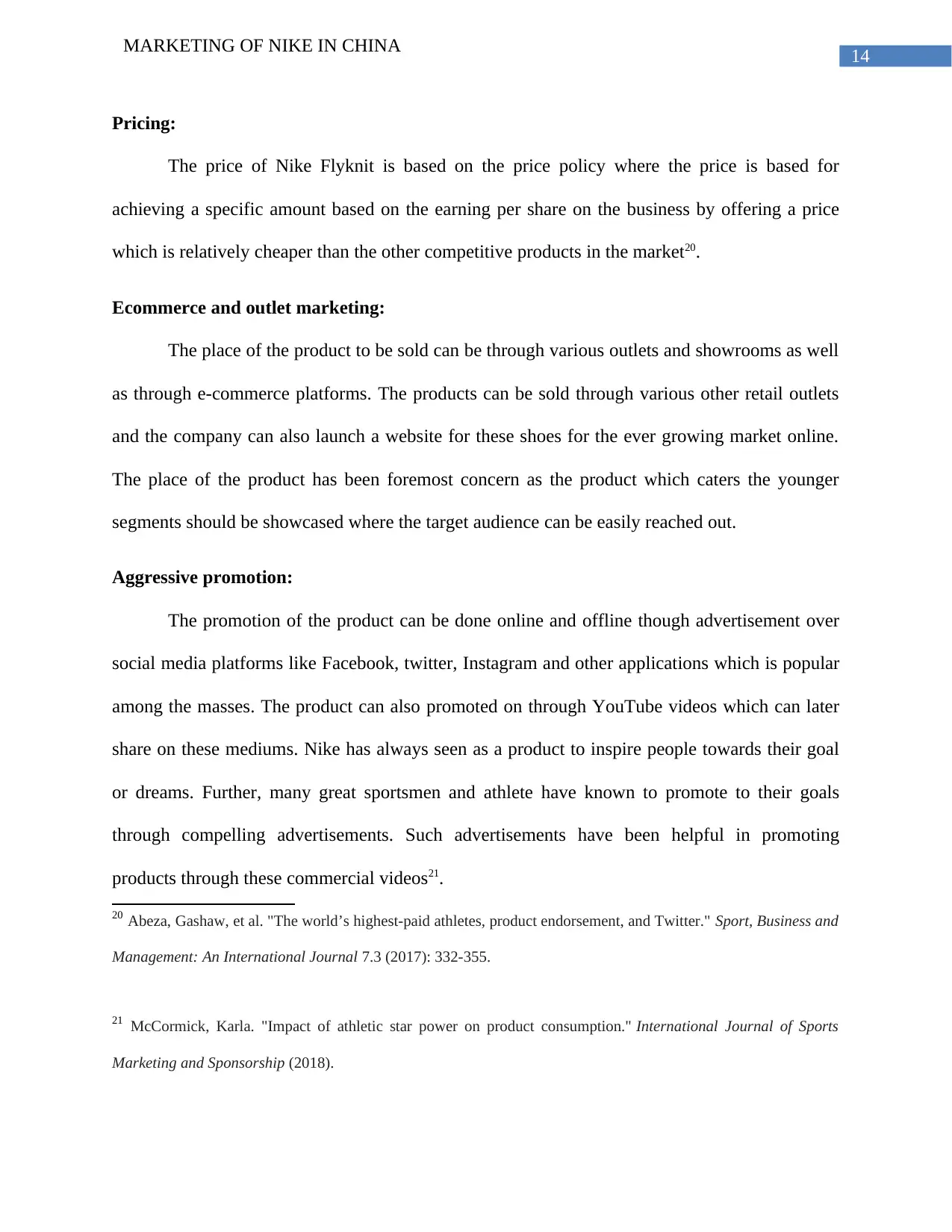
14
MARKETING OF NIKE IN CHINA
Pricing:
The price of Nike Flyknit is based on the price policy where the price is based for
achieving a specific amount based on the earning per share on the business by offering a price
which is relatively cheaper than the other competitive products in the market20.
Ecommerce and outlet marketing:
The place of the product to be sold can be through various outlets and showrooms as well
as through e-commerce platforms. The products can be sold through various other retail outlets
and the company can also launch a website for these shoes for the ever growing market online.
The place of the product has been foremost concern as the product which caters the younger
segments should be showcased where the target audience can be easily reached out.
Aggressive promotion:
The promotion of the product can be done online and offline though advertisement over
social media platforms like Facebook, twitter, Instagram and other applications which is popular
among the masses. The product can also promoted on through YouTube videos which can later
share on these mediums. Nike has always seen as a product to inspire people towards their goal
or dreams. Further, many great sportsmen and athlete have known to promote to their goals
through compelling advertisements. Such advertisements have been helpful in promoting
products through these commercial videos21.
20 Abeza, Gashaw, et al. "The world’s highest-paid athletes, product endorsement, and Twitter." Sport, Business and
Management: An International Journal 7.3 (2017): 332-355.
21 McCormick, Karla. "Impact of athletic star power on product consumption." International Journal of Sports
Marketing and Sponsorship (2018).
MARKETING OF NIKE IN CHINA
Pricing:
The price of Nike Flyknit is based on the price policy where the price is based for
achieving a specific amount based on the earning per share on the business by offering a price
which is relatively cheaper than the other competitive products in the market20.
Ecommerce and outlet marketing:
The place of the product to be sold can be through various outlets and showrooms as well
as through e-commerce platforms. The products can be sold through various other retail outlets
and the company can also launch a website for these shoes for the ever growing market online.
The place of the product has been foremost concern as the product which caters the younger
segments should be showcased where the target audience can be easily reached out.
Aggressive promotion:
The promotion of the product can be done online and offline though advertisement over
social media platforms like Facebook, twitter, Instagram and other applications which is popular
among the masses. The product can also promoted on through YouTube videos which can later
share on these mediums. Nike has always seen as a product to inspire people towards their goal
or dreams. Further, many great sportsmen and athlete have known to promote to their goals
through compelling advertisements. Such advertisements have been helpful in promoting
products through these commercial videos21.
20 Abeza, Gashaw, et al. "The world’s highest-paid athletes, product endorsement, and Twitter." Sport, Business and
Management: An International Journal 7.3 (2017): 332-355.
21 McCormick, Karla. "Impact of athletic star power on product consumption." International Journal of Sports
Marketing and Sponsorship (2018).
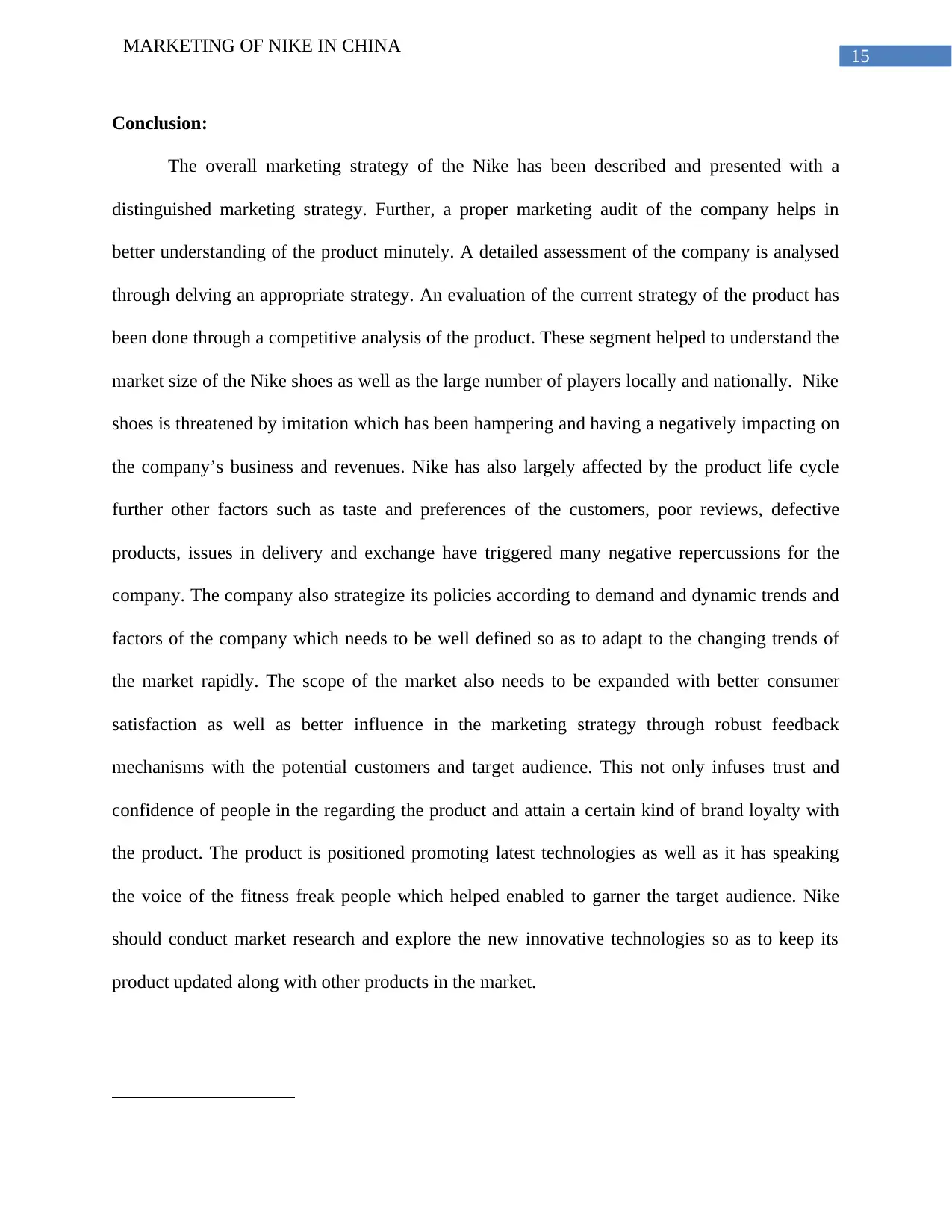
15
MARKETING OF NIKE IN CHINA
Conclusion:
The overall marketing strategy of the Nike has been described and presented with a
distinguished marketing strategy. Further, a proper marketing audit of the company helps in
better understanding of the product minutely. A detailed assessment of the company is analysed
through delving an appropriate strategy. An evaluation of the current strategy of the product has
been done through a competitive analysis of the product. These segment helped to understand the
market size of the Nike shoes as well as the large number of players locally and nationally. Nike
shoes is threatened by imitation which has been hampering and having a negatively impacting on
the company’s business and revenues. Nike has also largely affected by the product life cycle
further other factors such as taste and preferences of the customers, poor reviews, defective
products, issues in delivery and exchange have triggered many negative repercussions for the
company. The company also strategize its policies according to demand and dynamic trends and
factors of the company which needs to be well defined so as to adapt to the changing trends of
the market rapidly. The scope of the market also needs to be expanded with better consumer
satisfaction as well as better influence in the marketing strategy through robust feedback
mechanisms with the potential customers and target audience. This not only infuses trust and
confidence of people in the regarding the product and attain a certain kind of brand loyalty with
the product. The product is positioned promoting latest technologies as well as it has speaking
the voice of the fitness freak people which helped enabled to garner the target audience. Nike
should conduct market research and explore the new innovative technologies so as to keep its
product updated along with other products in the market.
MARKETING OF NIKE IN CHINA
Conclusion:
The overall marketing strategy of the Nike has been described and presented with a
distinguished marketing strategy. Further, a proper marketing audit of the company helps in
better understanding of the product minutely. A detailed assessment of the company is analysed
through delving an appropriate strategy. An evaluation of the current strategy of the product has
been done through a competitive analysis of the product. These segment helped to understand the
market size of the Nike shoes as well as the large number of players locally and nationally. Nike
shoes is threatened by imitation which has been hampering and having a negatively impacting on
the company’s business and revenues. Nike has also largely affected by the product life cycle
further other factors such as taste and preferences of the customers, poor reviews, defective
products, issues in delivery and exchange have triggered many negative repercussions for the
company. The company also strategize its policies according to demand and dynamic trends and
factors of the company which needs to be well defined so as to adapt to the changing trends of
the market rapidly. The scope of the market also needs to be expanded with better consumer
satisfaction as well as better influence in the marketing strategy through robust feedback
mechanisms with the potential customers and target audience. This not only infuses trust and
confidence of people in the regarding the product and attain a certain kind of brand loyalty with
the product. The product is positioned promoting latest technologies as well as it has speaking
the voice of the fitness freak people which helped enabled to garner the target audience. Nike
should conduct market research and explore the new innovative technologies so as to keep its
product updated along with other products in the market.
Secure Best Marks with AI Grader
Need help grading? Try our AI Grader for instant feedback on your assignments.
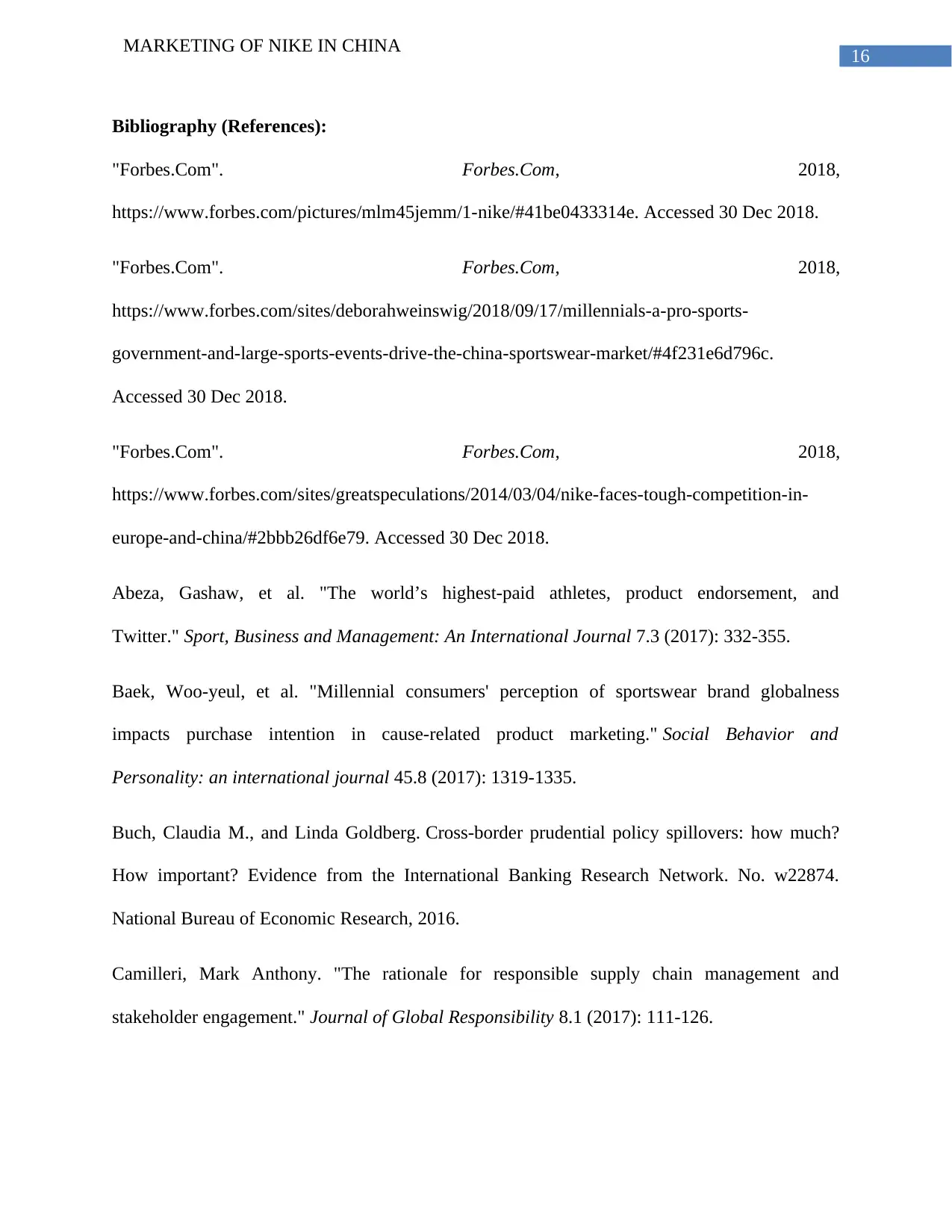
16
MARKETING OF NIKE IN CHINA
Bibliography (References):
"Forbes.Com". Forbes.Com, 2018,
https://www.forbes.com/pictures/mlm45jemm/1-nike/#41be0433314e. Accessed 30 Dec 2018.
"Forbes.Com". Forbes.Com, 2018,
https://www.forbes.com/sites/deborahweinswig/2018/09/17/millennials-a-pro-sports-
government-and-large-sports-events-drive-the-china-sportswear-market/#4f231e6d796c.
Accessed 30 Dec 2018.
"Forbes.Com". Forbes.Com, 2018,
https://www.forbes.com/sites/greatspeculations/2014/03/04/nike-faces-tough-competition-in-
europe-and-china/#2bbb26df6e79. Accessed 30 Dec 2018.
Abeza, Gashaw, et al. "The world’s highest-paid athletes, product endorsement, and
Twitter." Sport, Business and Management: An International Journal 7.3 (2017): 332-355.
Baek, Woo-yeul, et al. "Millennial consumers' perception of sportswear brand globalness
impacts purchase intention in cause-related product marketing." Social Behavior and
Personality: an international journal 45.8 (2017): 1319-1335.
Buch, Claudia M., and Linda Goldberg. Cross-border prudential policy spillovers: how much?
How important? Evidence from the International Banking Research Network. No. w22874.
National Bureau of Economic Research, 2016.
Camilleri, Mark Anthony. "The rationale for responsible supply chain management and
stakeholder engagement." Journal of Global Responsibility 8.1 (2017): 111-126.
MARKETING OF NIKE IN CHINA
Bibliography (References):
"Forbes.Com". Forbes.Com, 2018,
https://www.forbes.com/pictures/mlm45jemm/1-nike/#41be0433314e. Accessed 30 Dec 2018.
"Forbes.Com". Forbes.Com, 2018,
https://www.forbes.com/sites/deborahweinswig/2018/09/17/millennials-a-pro-sports-
government-and-large-sports-events-drive-the-china-sportswear-market/#4f231e6d796c.
Accessed 30 Dec 2018.
"Forbes.Com". Forbes.Com, 2018,
https://www.forbes.com/sites/greatspeculations/2014/03/04/nike-faces-tough-competition-in-
europe-and-china/#2bbb26df6e79. Accessed 30 Dec 2018.
Abeza, Gashaw, et al. "The world’s highest-paid athletes, product endorsement, and
Twitter." Sport, Business and Management: An International Journal 7.3 (2017): 332-355.
Baek, Woo-yeul, et al. "Millennial consumers' perception of sportswear brand globalness
impacts purchase intention in cause-related product marketing." Social Behavior and
Personality: an international journal 45.8 (2017): 1319-1335.
Buch, Claudia M., and Linda Goldberg. Cross-border prudential policy spillovers: how much?
How important? Evidence from the International Banking Research Network. No. w22874.
National Bureau of Economic Research, 2016.
Camilleri, Mark Anthony. "The rationale for responsible supply chain management and
stakeholder engagement." Journal of Global Responsibility 8.1 (2017): 111-126.
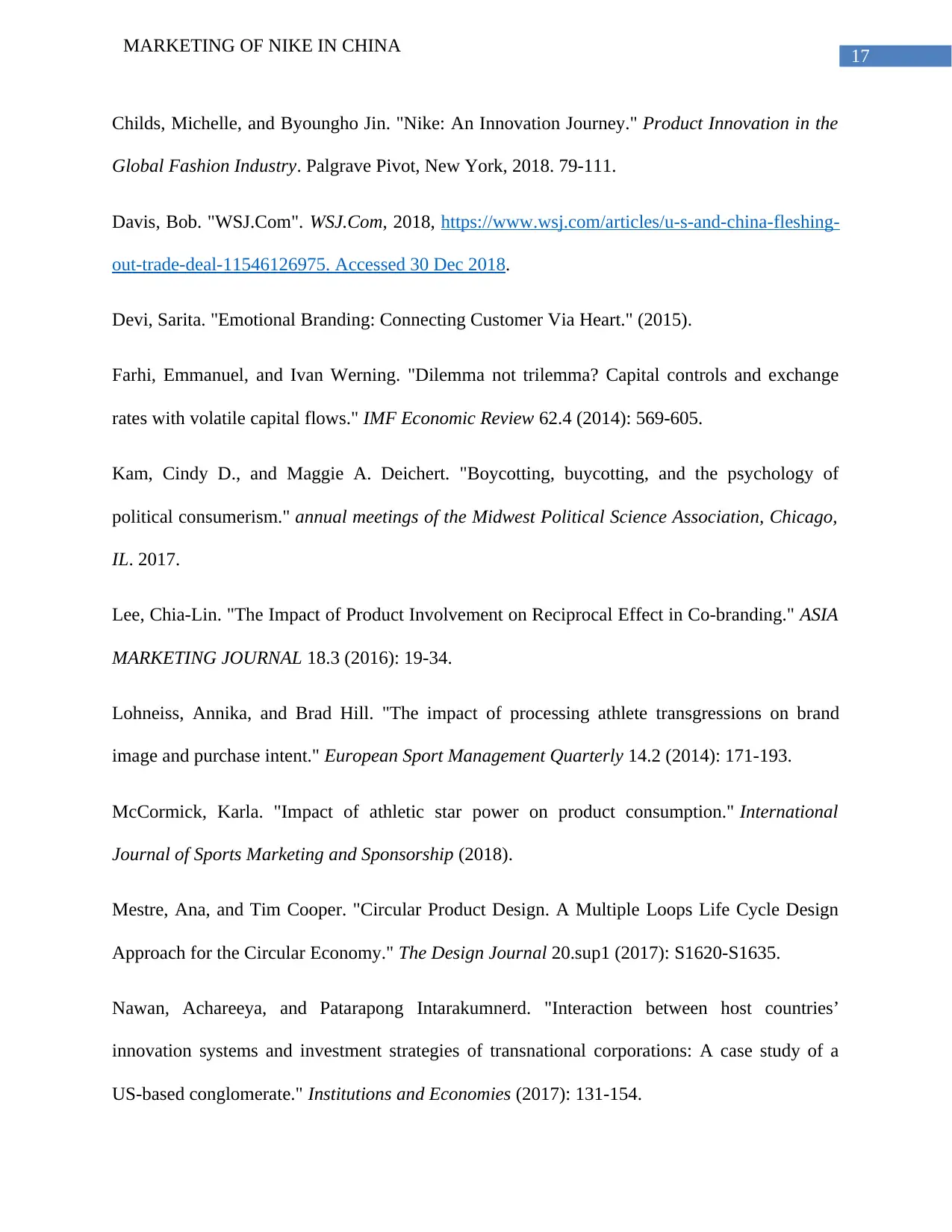
17
MARKETING OF NIKE IN CHINA
Childs, Michelle, and Byoungho Jin. "Nike: An Innovation Journey." Product Innovation in the
Global Fashion Industry. Palgrave Pivot, New York, 2018. 79-111.
Davis, Bob. "WSJ.Com". WSJ.Com, 2018, https://www.wsj.com/articles/u-s-and-china-fleshing-
out-trade-deal-11546126975. Accessed 30 Dec 2018.
Devi, Sarita. "Emotional Branding: Connecting Customer Via Heart." (2015).
Farhi, Emmanuel, and Ivan Werning. "Dilemma not trilemma? Capital controls and exchange
rates with volatile capital flows." IMF Economic Review 62.4 (2014): 569-605.
Kam, Cindy D., and Maggie A. Deichert. "Boycotting, buycotting, and the psychology of
political consumerism." annual meetings of the Midwest Political Science Association, Chicago,
IL. 2017.
Lee, Chia-Lin. "The Impact of Product Involvement on Reciprocal Effect in Co-branding." ASIA
MARKETING JOURNAL 18.3 (2016): 19-34.
Lohneiss, Annika, and Brad Hill. "The impact of processing athlete transgressions on brand
image and purchase intent." European Sport Management Quarterly 14.2 (2014): 171-193.
McCormick, Karla. "Impact of athletic star power on product consumption." International
Journal of Sports Marketing and Sponsorship (2018).
Mestre, Ana, and Tim Cooper. "Circular Product Design. A Multiple Loops Life Cycle Design
Approach for the Circular Economy." The Design Journal 20.sup1 (2017): S1620-S1635.
Nawan, Achareeya, and Patarapong Intarakumnerd. "Interaction between host countries’
innovation systems and investment strategies of transnational corporations: A case study of a
US-based conglomerate." Institutions and Economies (2017): 131-154.
MARKETING OF NIKE IN CHINA
Childs, Michelle, and Byoungho Jin. "Nike: An Innovation Journey." Product Innovation in the
Global Fashion Industry. Palgrave Pivot, New York, 2018. 79-111.
Davis, Bob. "WSJ.Com". WSJ.Com, 2018, https://www.wsj.com/articles/u-s-and-china-fleshing-
out-trade-deal-11546126975. Accessed 30 Dec 2018.
Devi, Sarita. "Emotional Branding: Connecting Customer Via Heart." (2015).
Farhi, Emmanuel, and Ivan Werning. "Dilemma not trilemma? Capital controls and exchange
rates with volatile capital flows." IMF Economic Review 62.4 (2014): 569-605.
Kam, Cindy D., and Maggie A. Deichert. "Boycotting, buycotting, and the psychology of
political consumerism." annual meetings of the Midwest Political Science Association, Chicago,
IL. 2017.
Lee, Chia-Lin. "The Impact of Product Involvement on Reciprocal Effect in Co-branding." ASIA
MARKETING JOURNAL 18.3 (2016): 19-34.
Lohneiss, Annika, and Brad Hill. "The impact of processing athlete transgressions on brand
image and purchase intent." European Sport Management Quarterly 14.2 (2014): 171-193.
McCormick, Karla. "Impact of athletic star power on product consumption." International
Journal of Sports Marketing and Sponsorship (2018).
Mestre, Ana, and Tim Cooper. "Circular Product Design. A Multiple Loops Life Cycle Design
Approach for the Circular Economy." The Design Journal 20.sup1 (2017): S1620-S1635.
Nawan, Achareeya, and Patarapong Intarakumnerd. "Interaction between host countries’
innovation systems and investment strategies of transnational corporations: A case study of a
US-based conglomerate." Institutions and Economies (2017): 131-154.
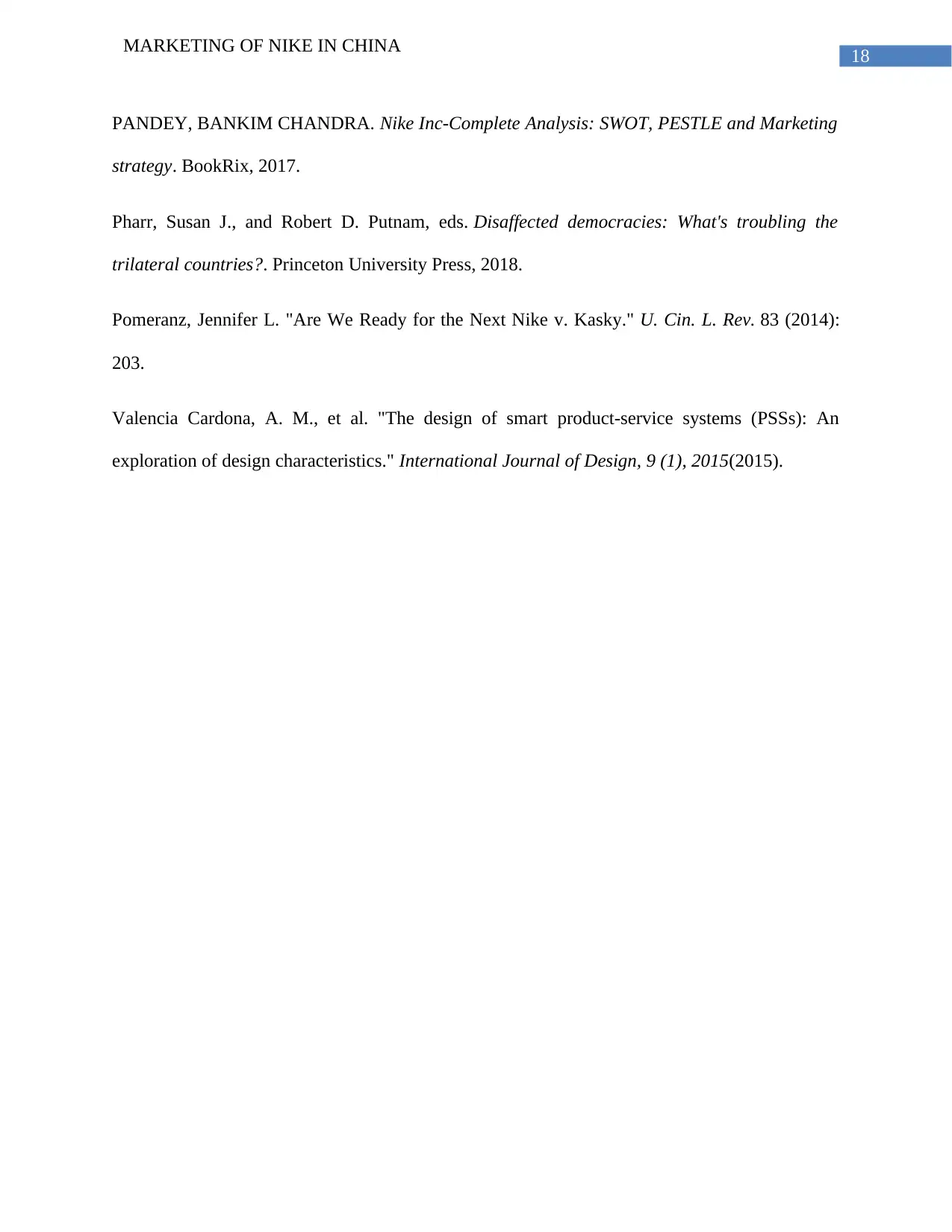
18
MARKETING OF NIKE IN CHINA
PANDEY, BANKIM CHANDRA. Nike Inc-Complete Analysis: SWOT, PESTLE and Marketing
strategy. BookRix, 2017.
Pharr, Susan J., and Robert D. Putnam, eds. Disaffected democracies: What's troubling the
trilateral countries?. Princeton University Press, 2018.
Pomeranz, Jennifer L. "Are We Ready for the Next Nike v. Kasky." U. Cin. L. Rev. 83 (2014):
203.
Valencia Cardona, A. M., et al. "The design of smart product-service systems (PSSs): An
exploration of design characteristics." International Journal of Design, 9 (1), 2015(2015).
MARKETING OF NIKE IN CHINA
PANDEY, BANKIM CHANDRA. Nike Inc-Complete Analysis: SWOT, PESTLE and Marketing
strategy. BookRix, 2017.
Pharr, Susan J., and Robert D. Putnam, eds. Disaffected democracies: What's troubling the
trilateral countries?. Princeton University Press, 2018.
Pomeranz, Jennifer L. "Are We Ready for the Next Nike v. Kasky." U. Cin. L. Rev. 83 (2014):
203.
Valencia Cardona, A. M., et al. "The design of smart product-service systems (PSSs): An
exploration of design characteristics." International Journal of Design, 9 (1), 2015(2015).
1 out of 19
Related Documents
Your All-in-One AI-Powered Toolkit for Academic Success.
+13062052269
info@desklib.com
Available 24*7 on WhatsApp / Email
![[object Object]](/_next/static/media/star-bottom.7253800d.svg)
Unlock your academic potential
© 2024 | Zucol Services PVT LTD | All rights reserved.





